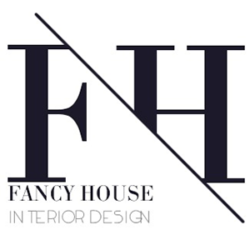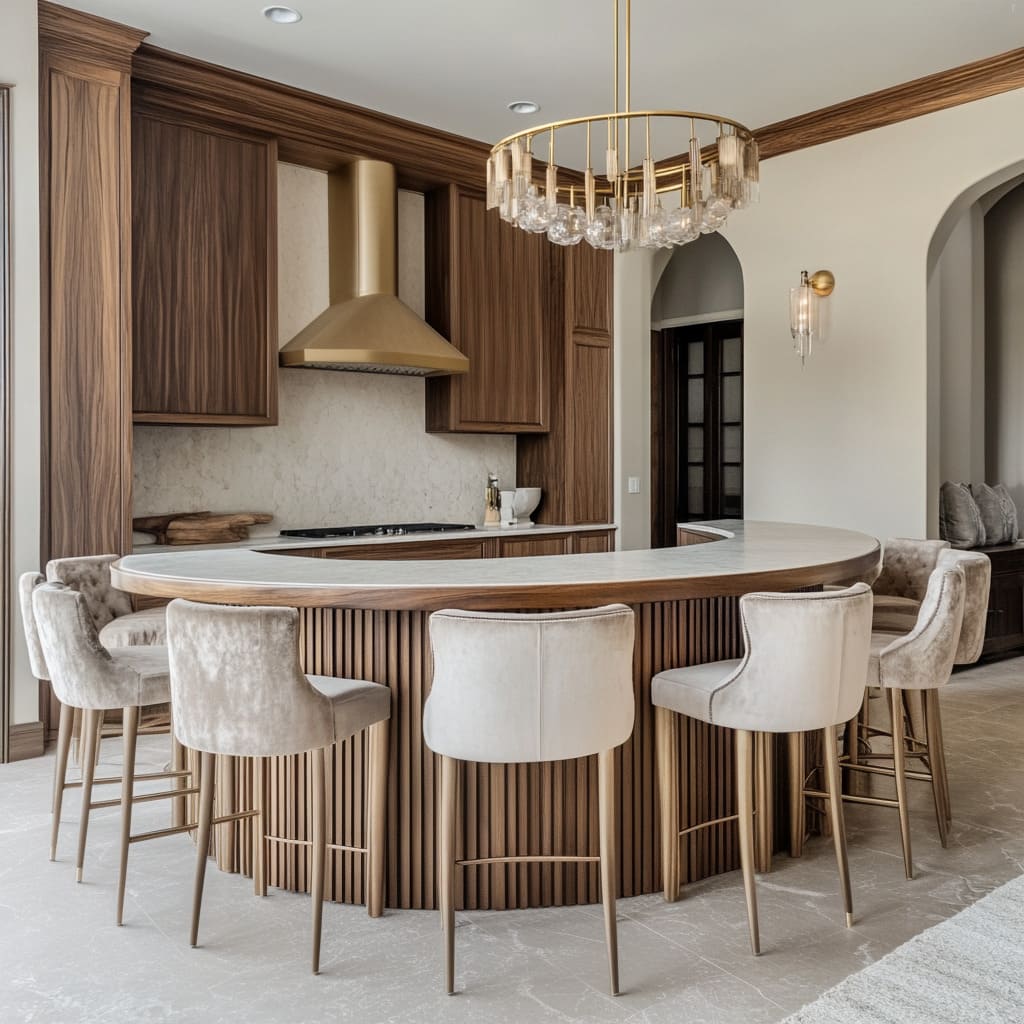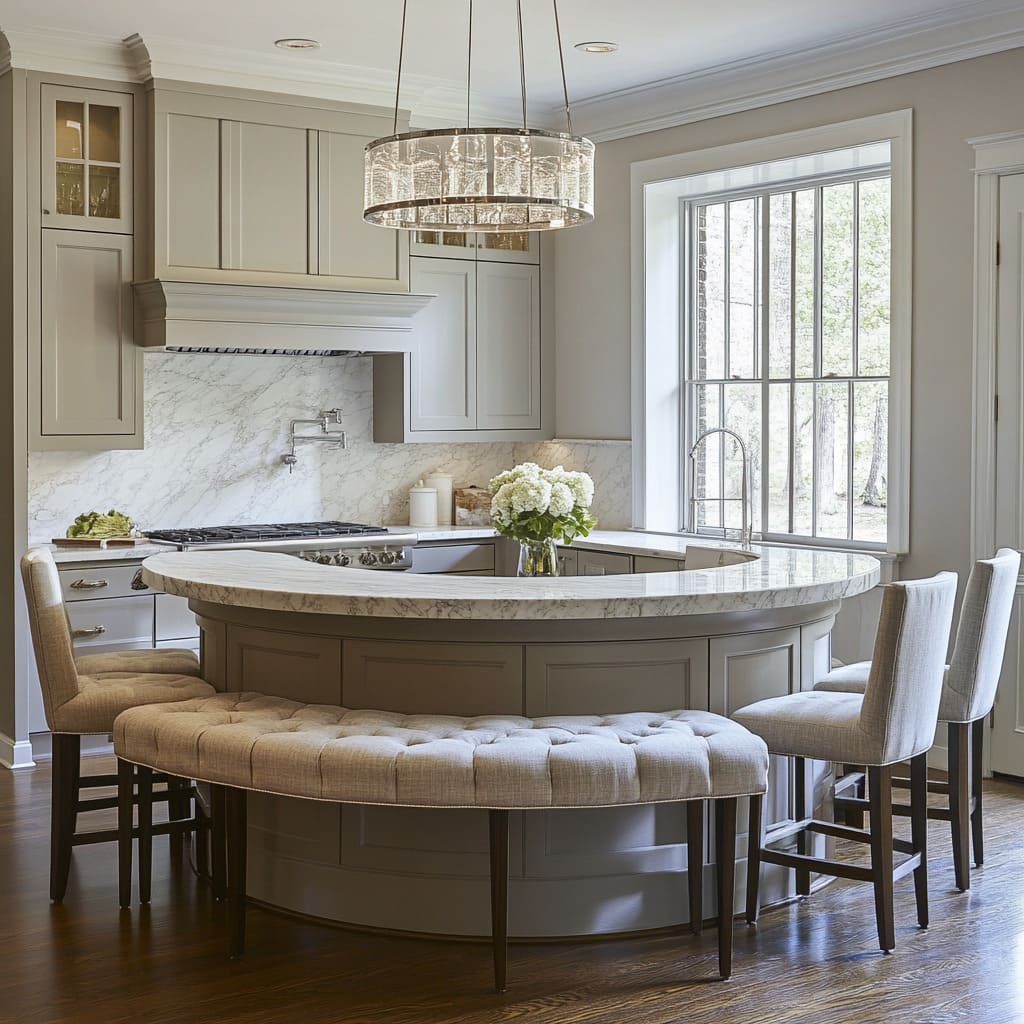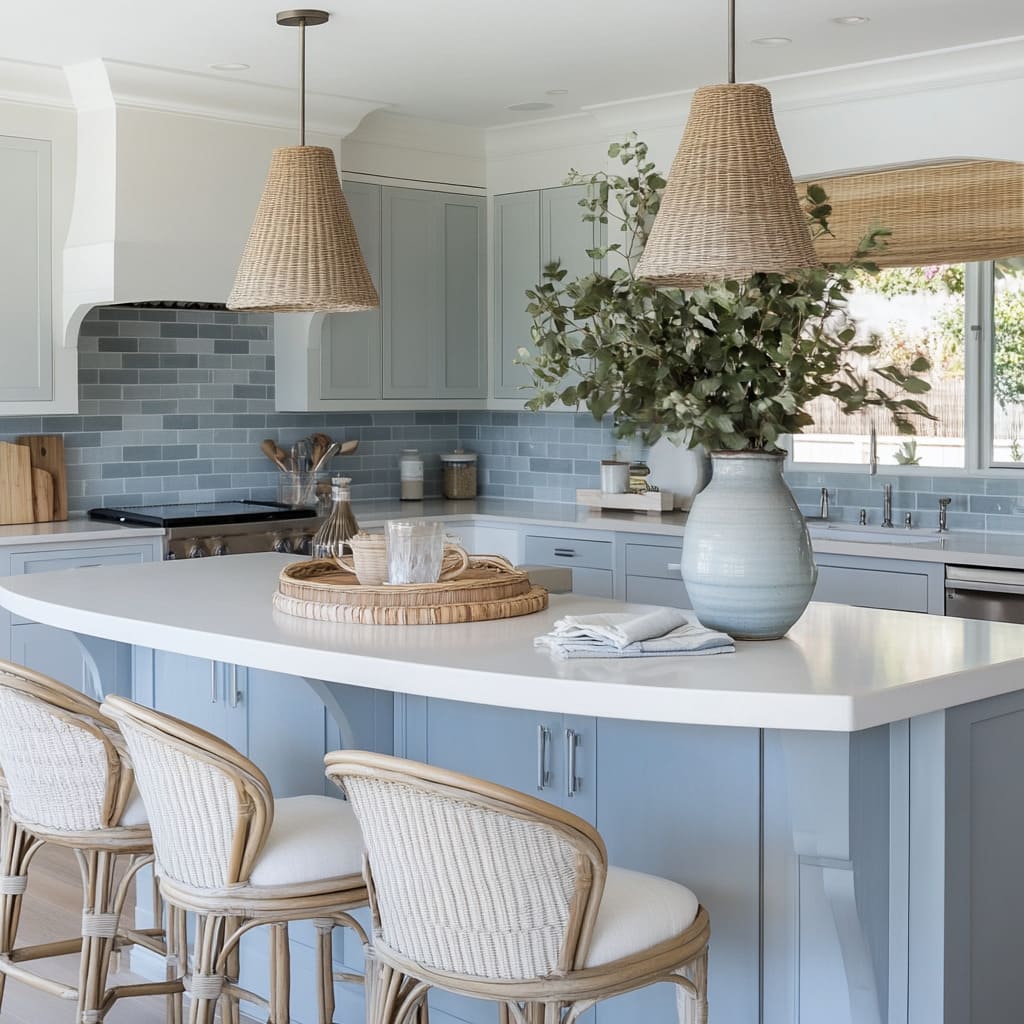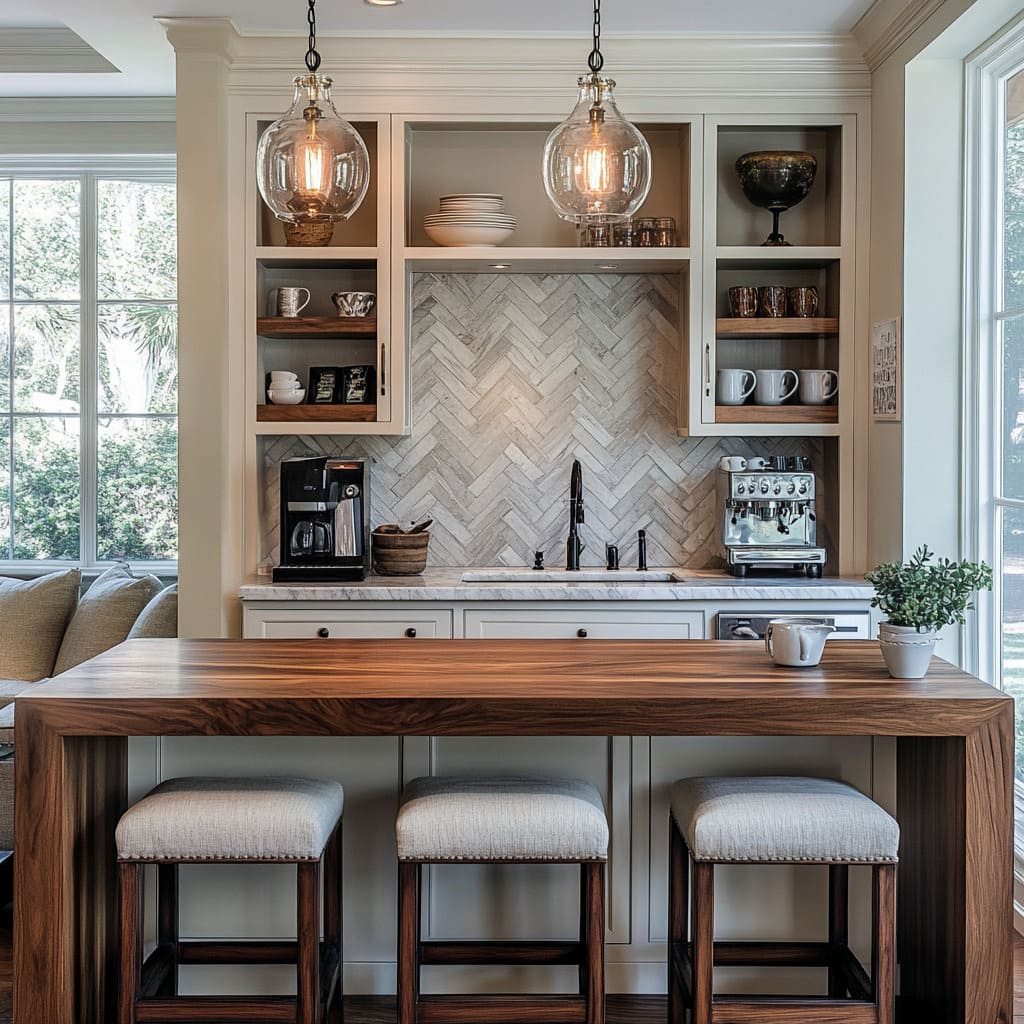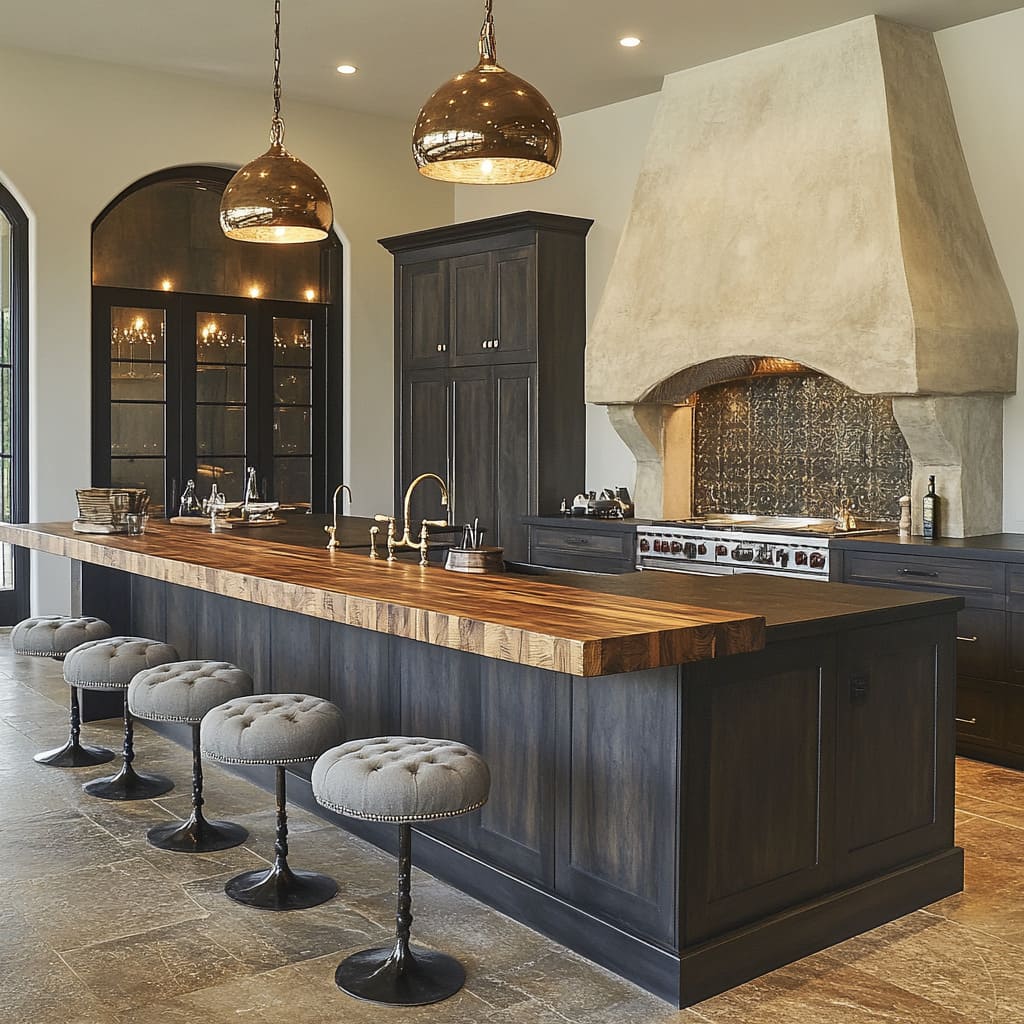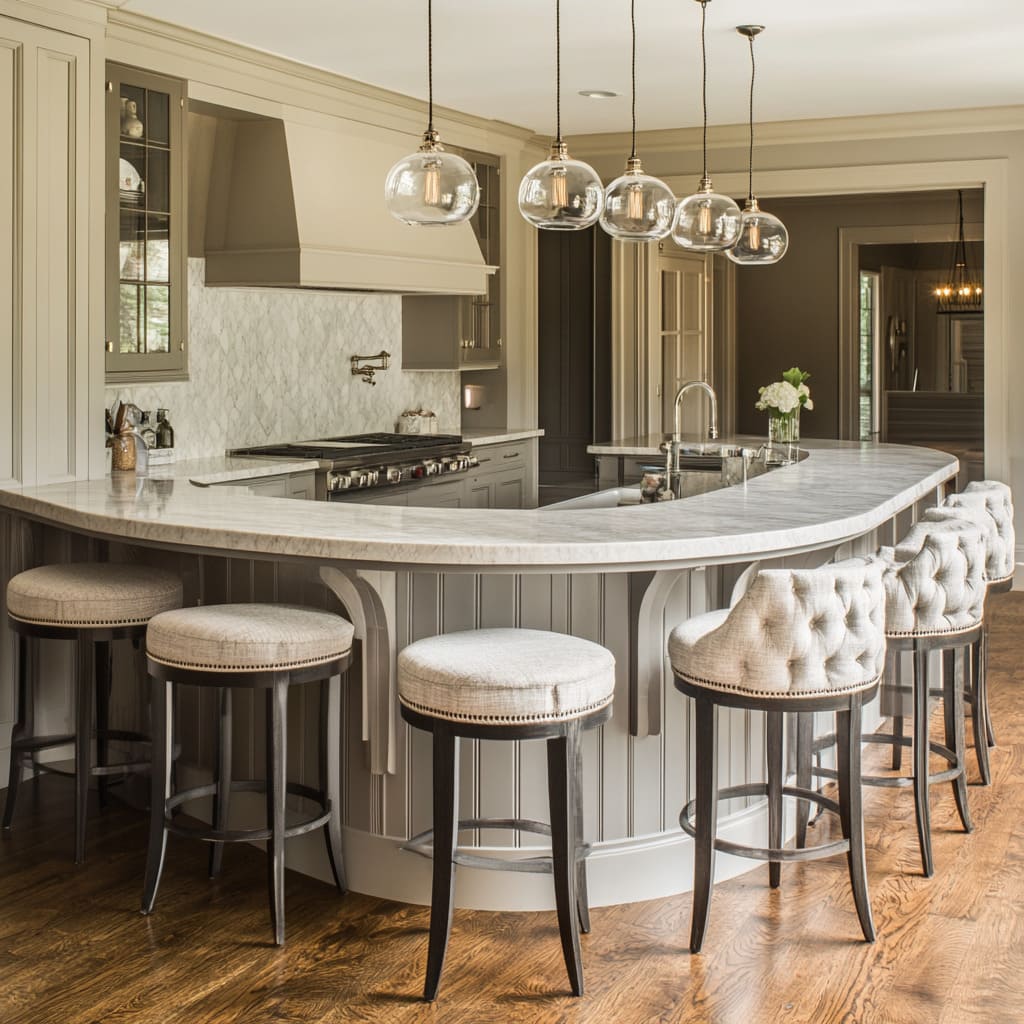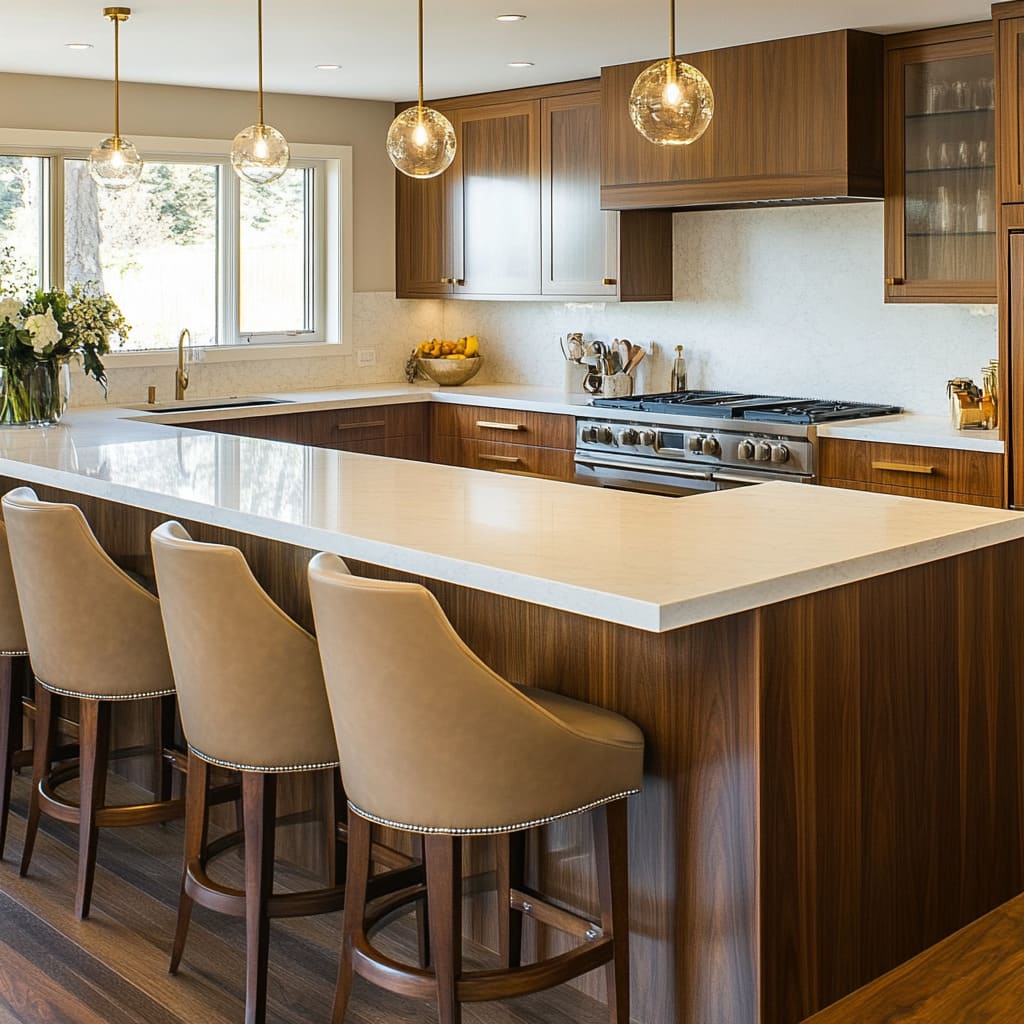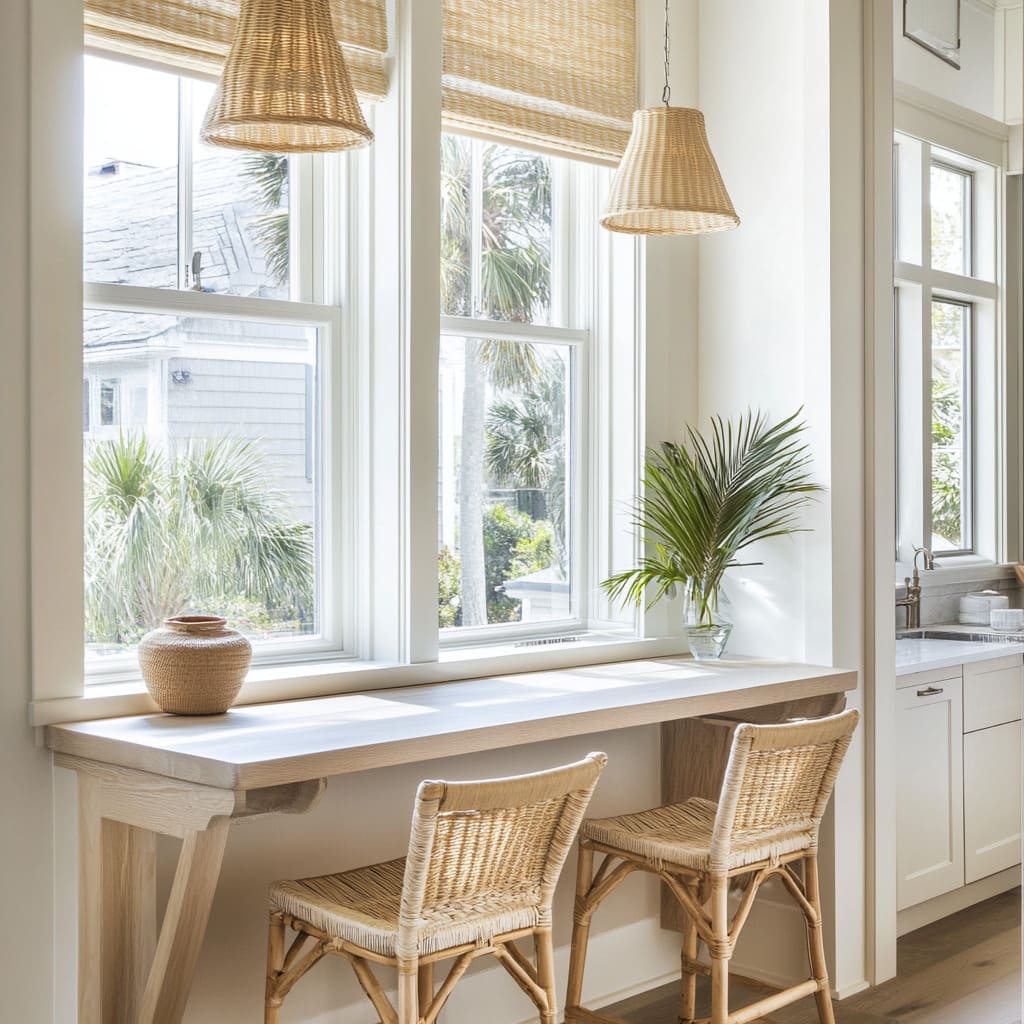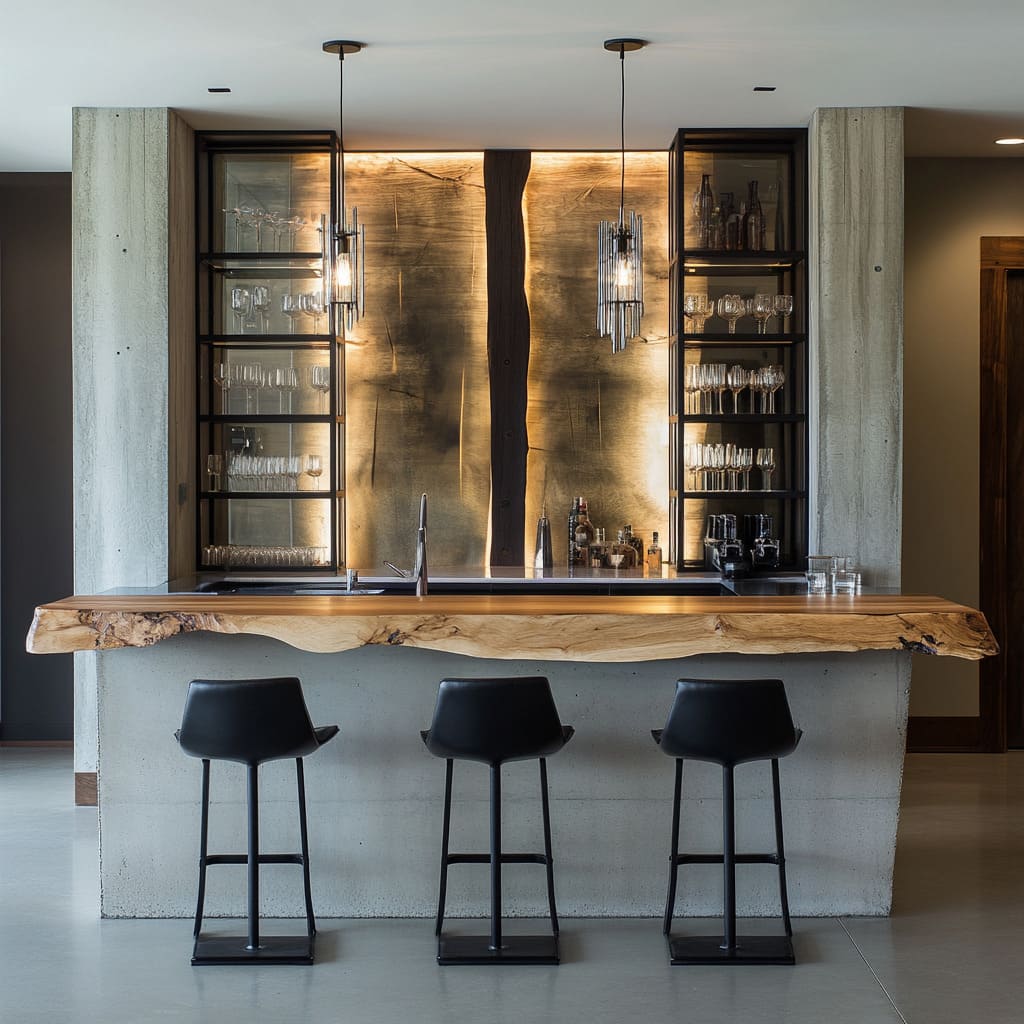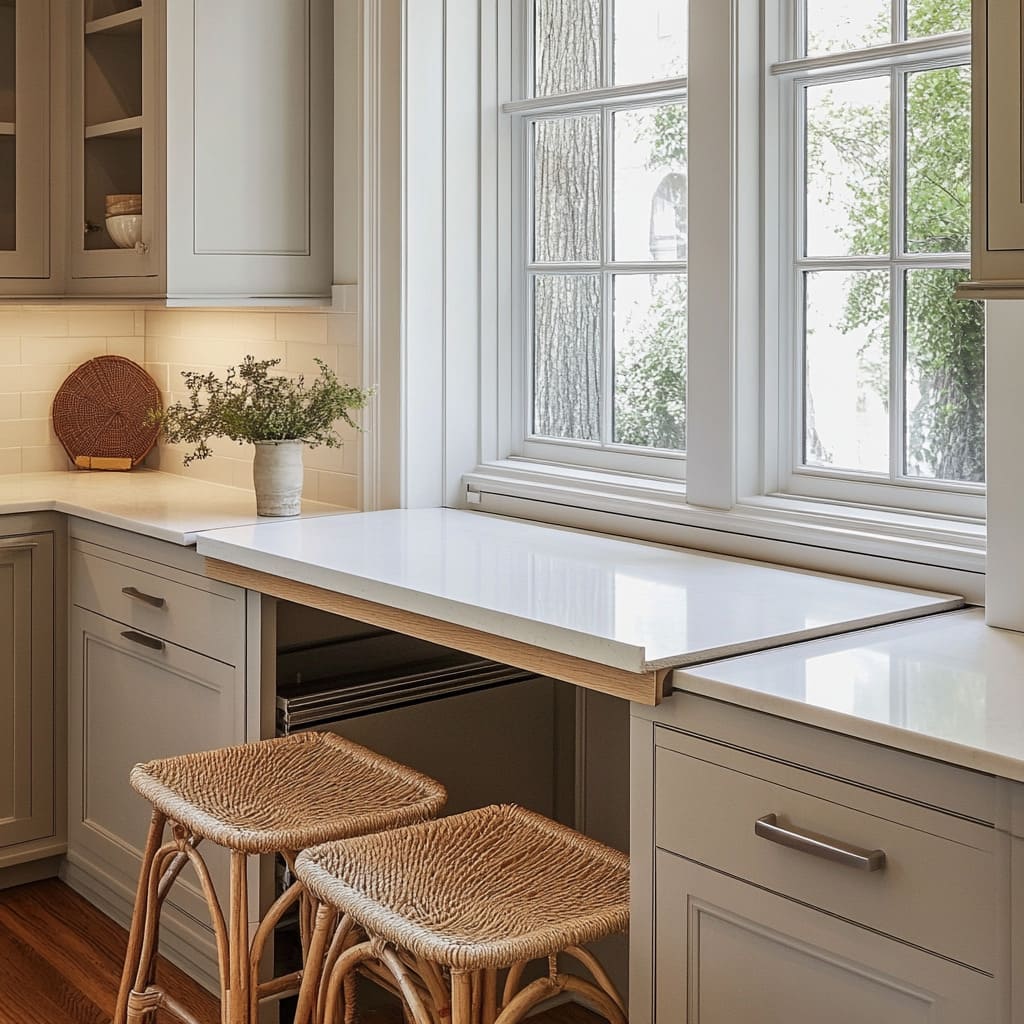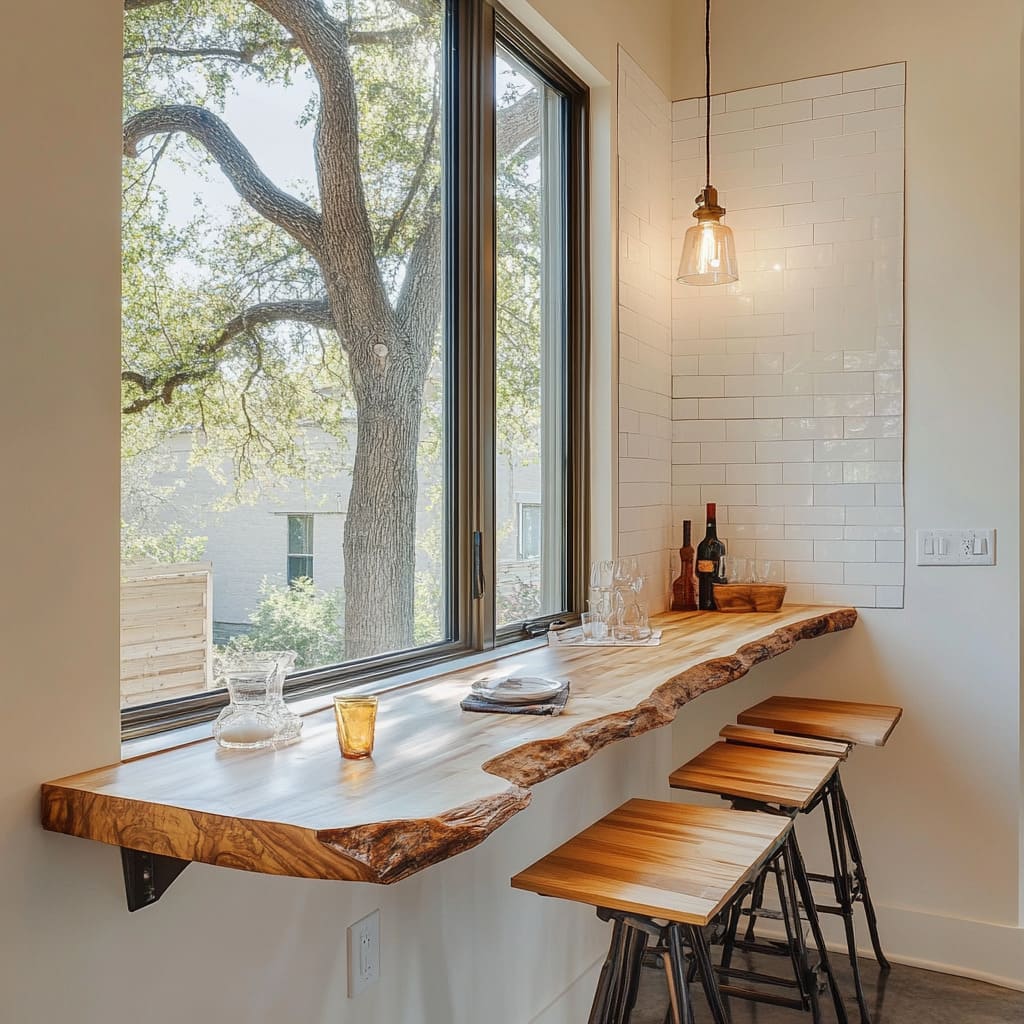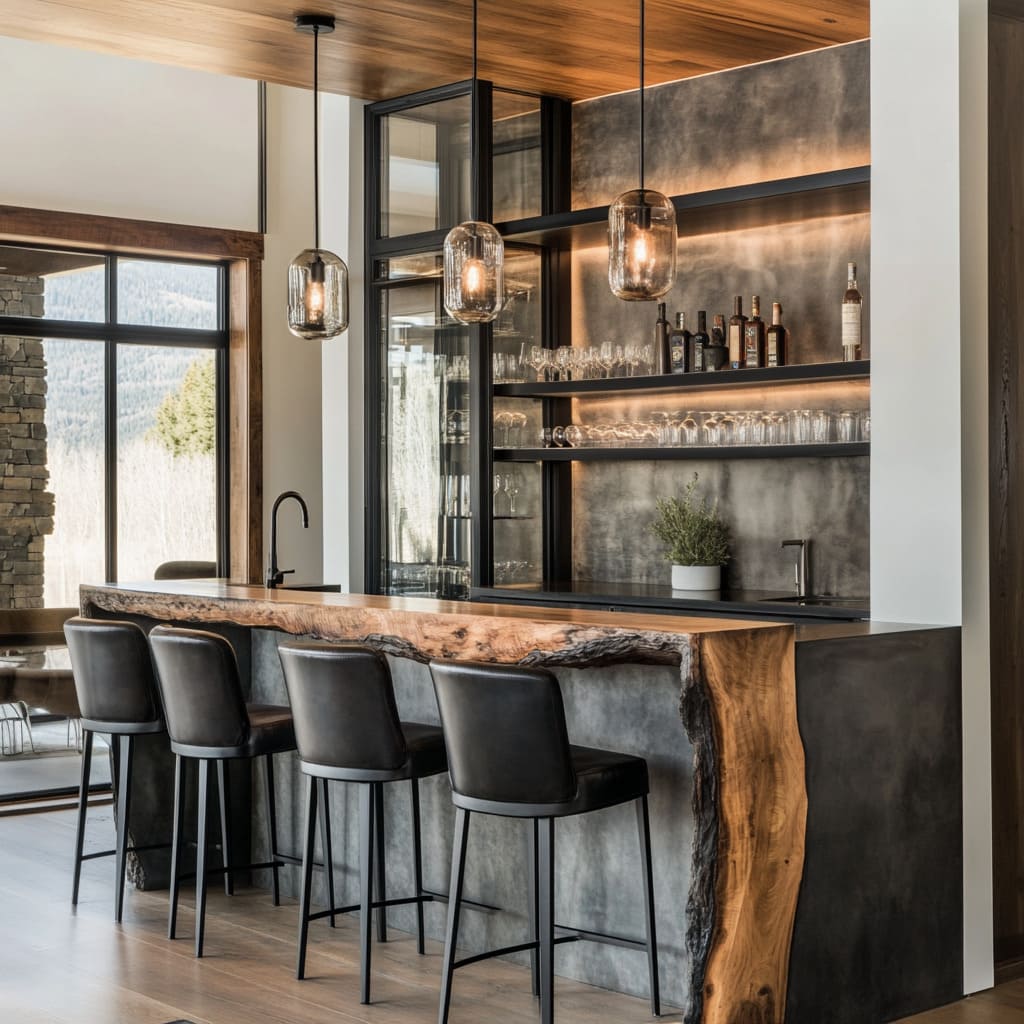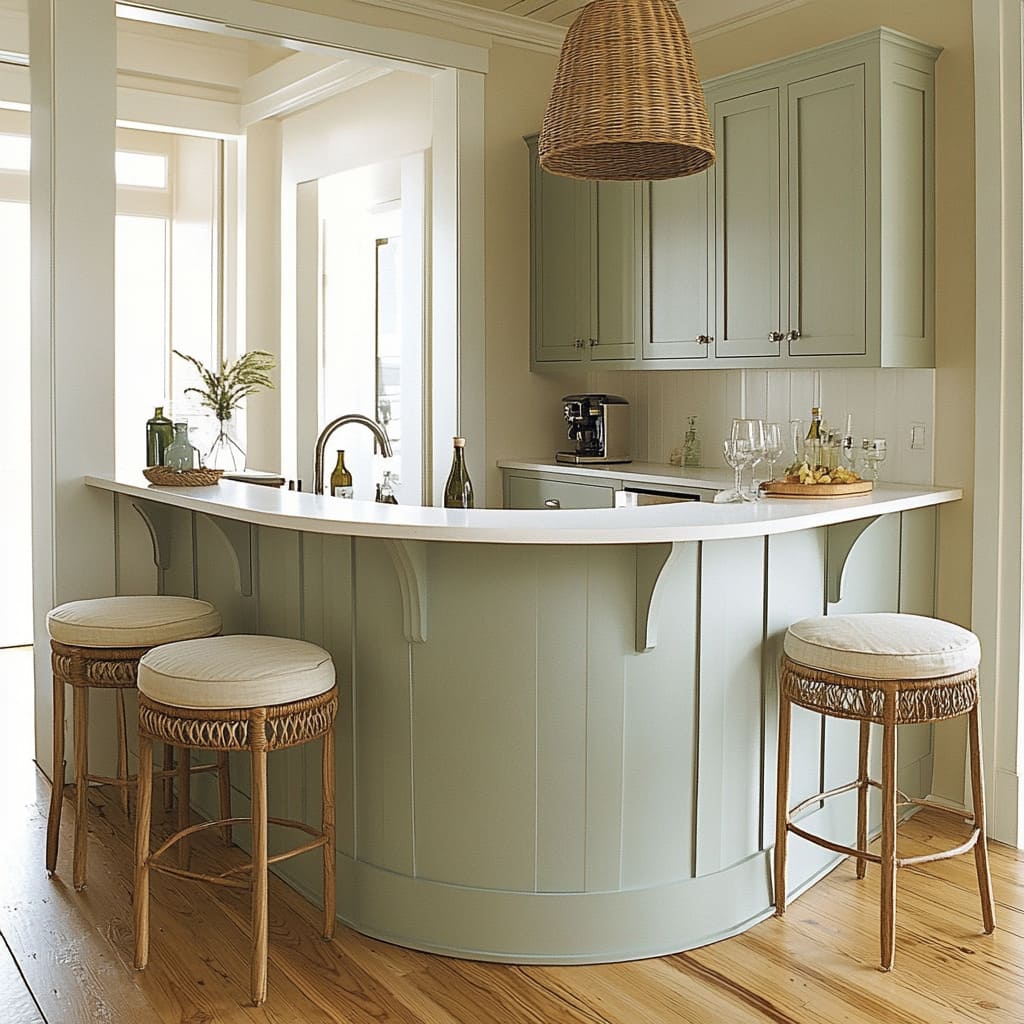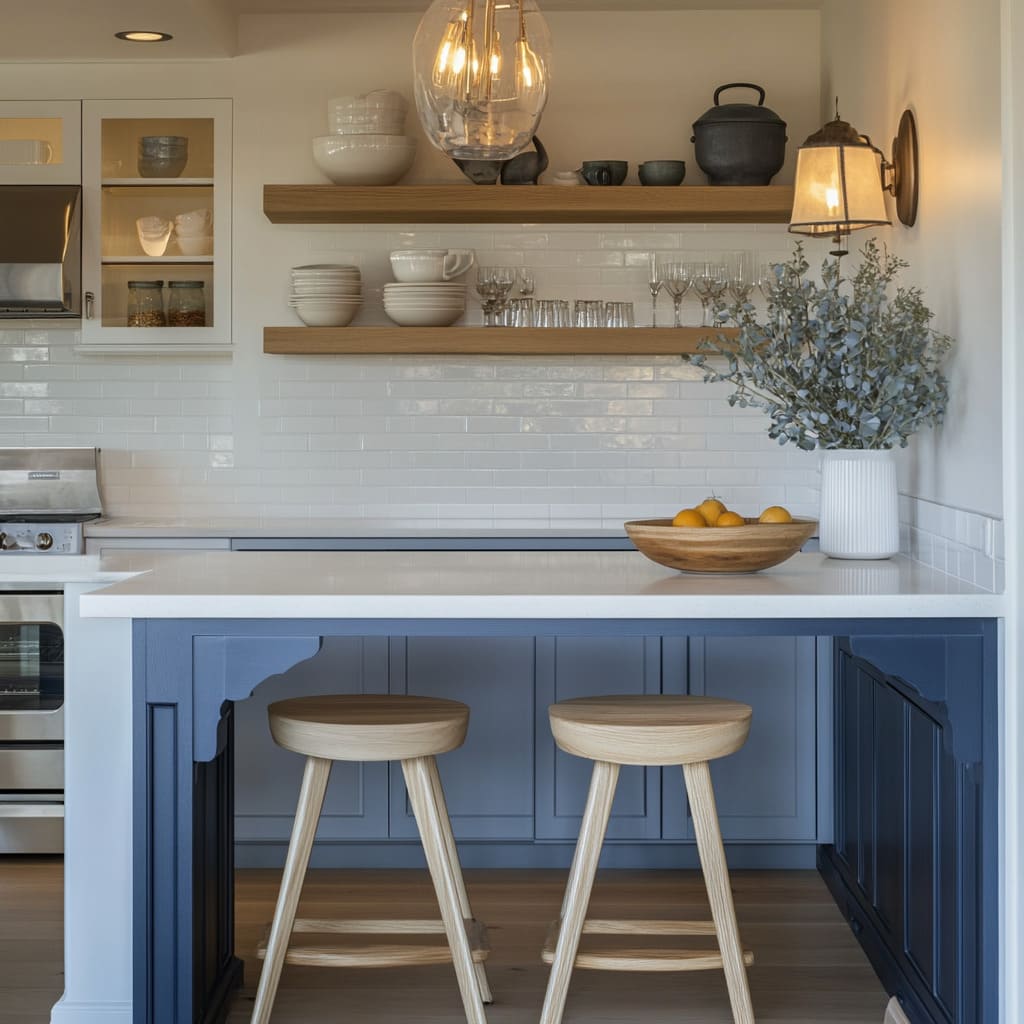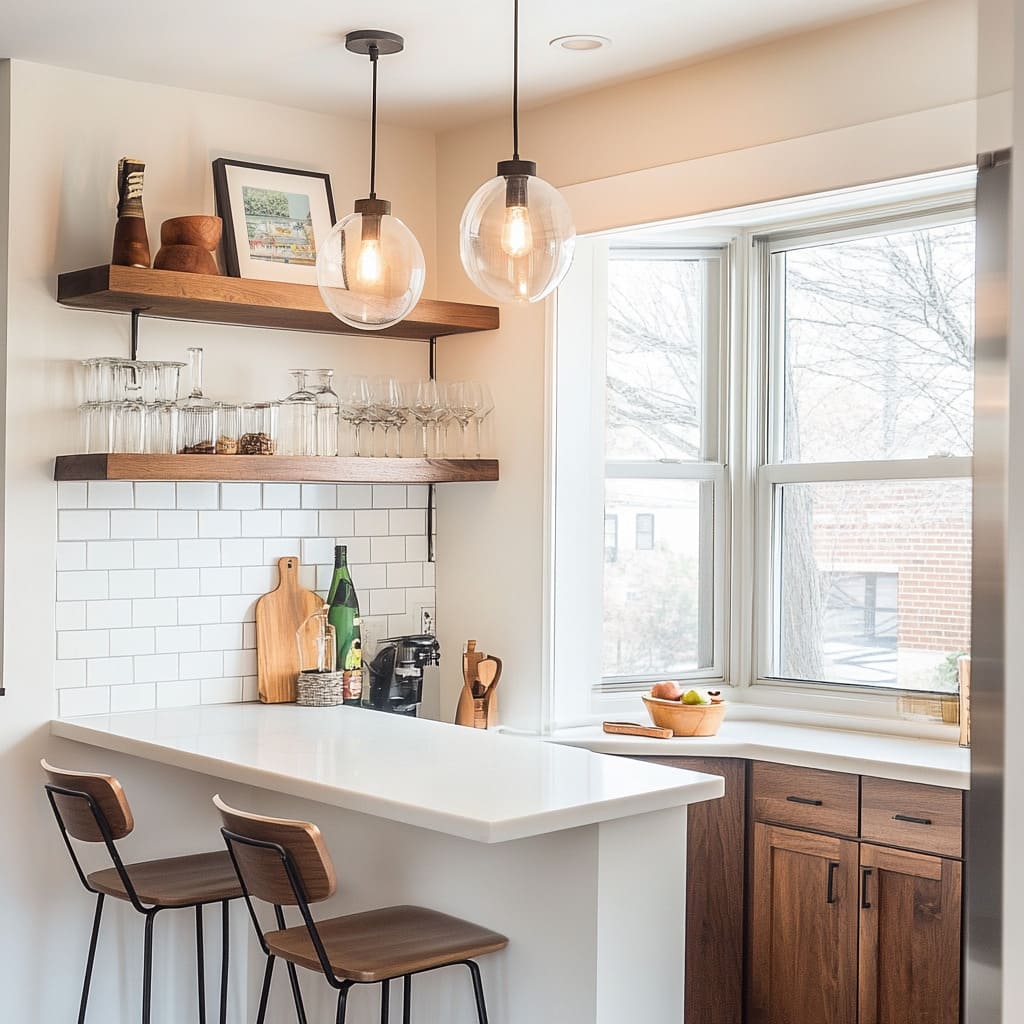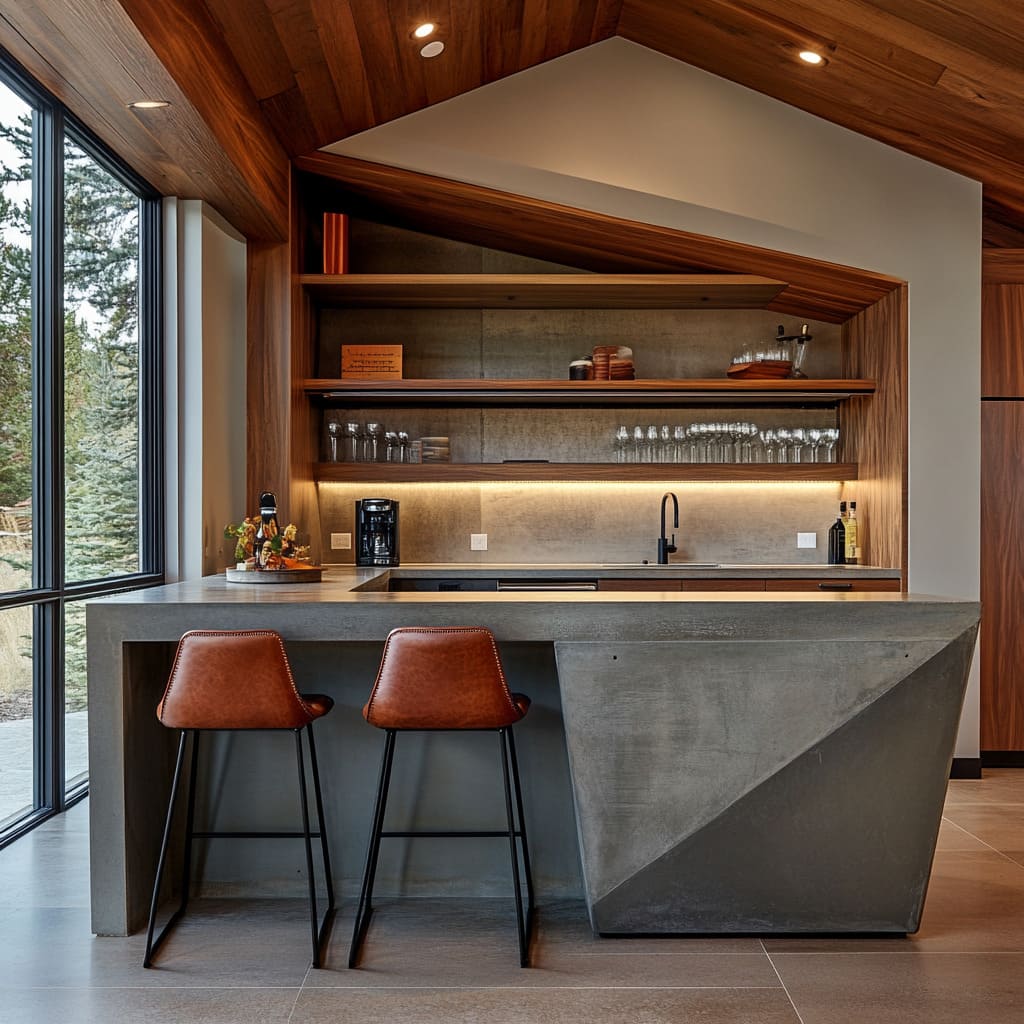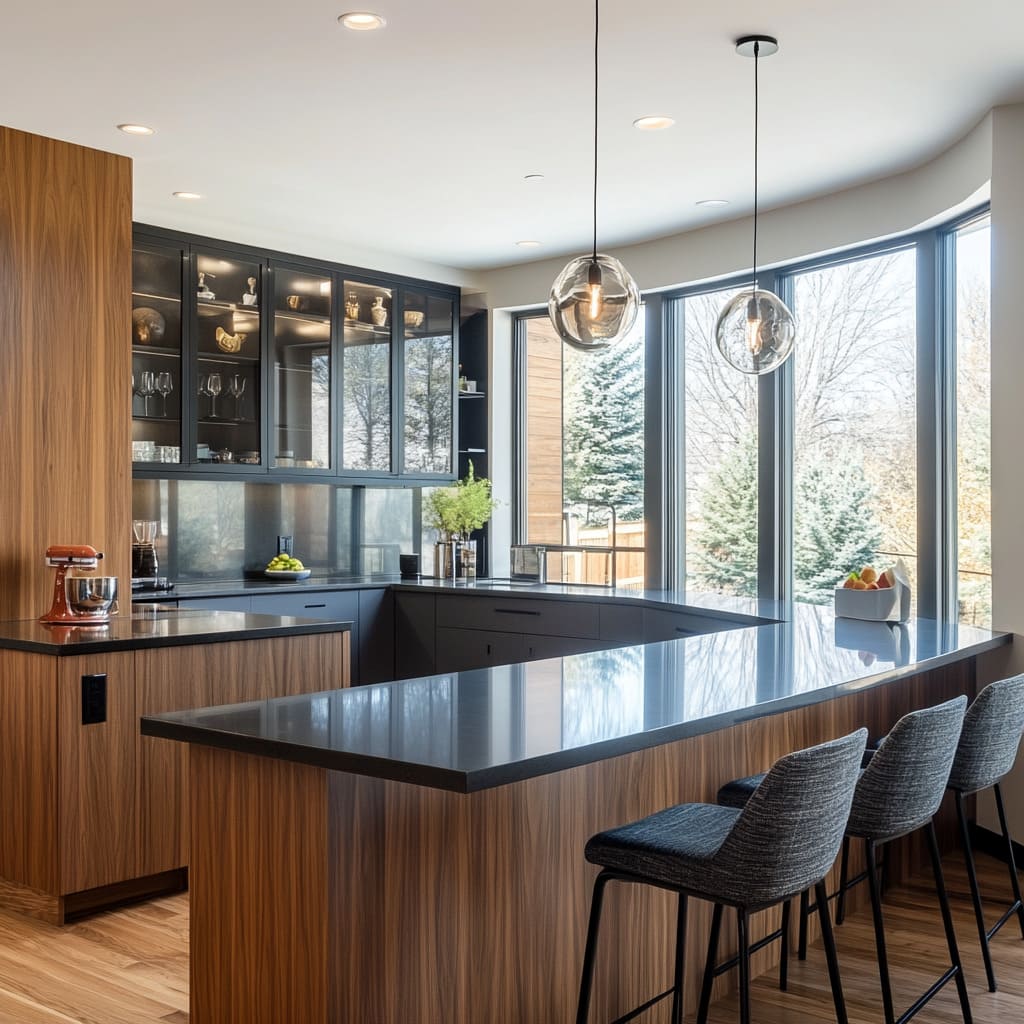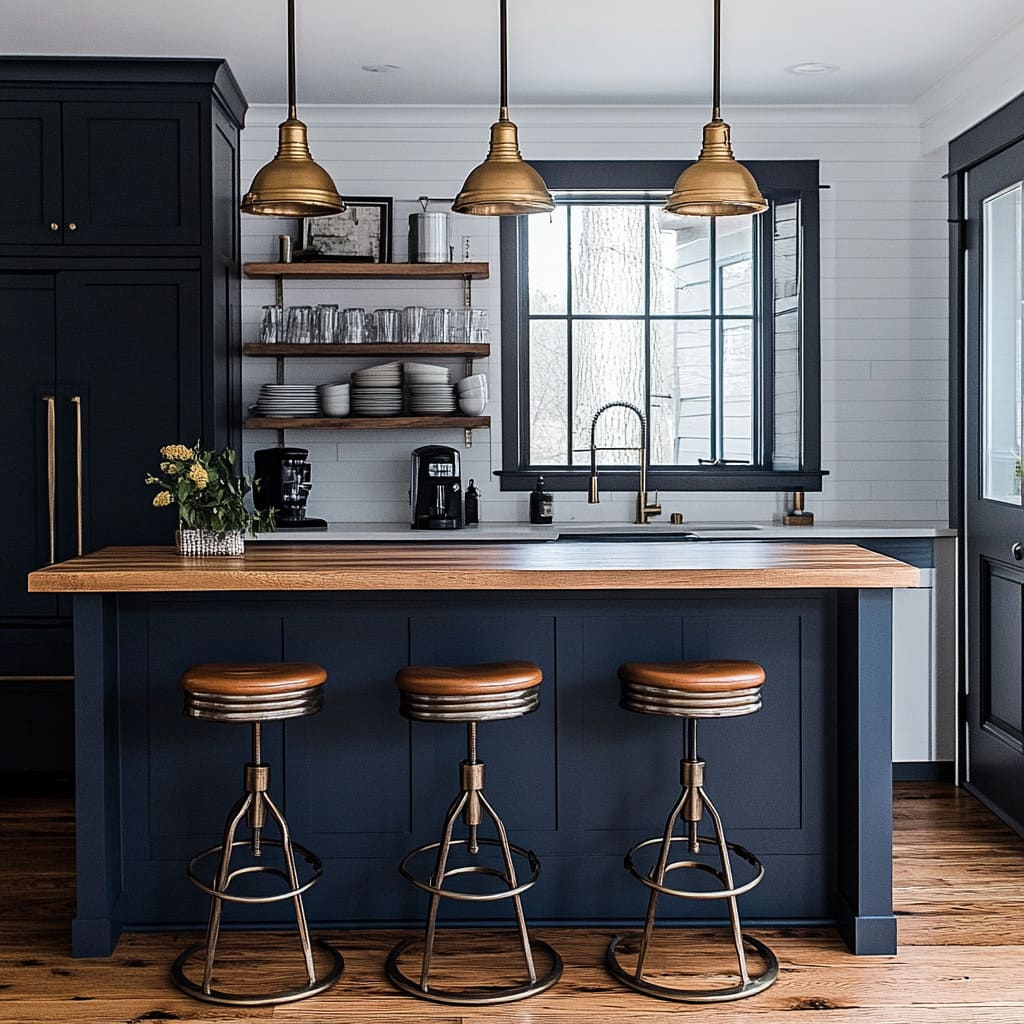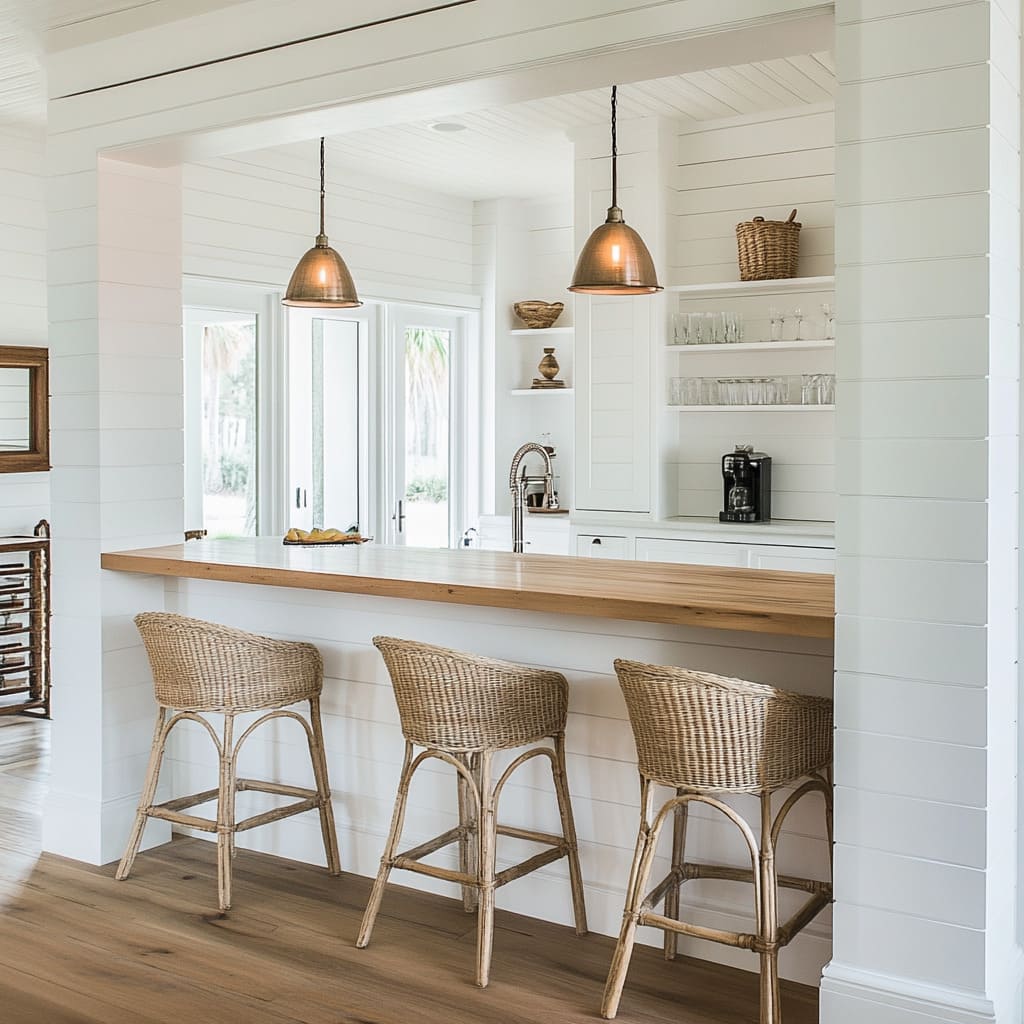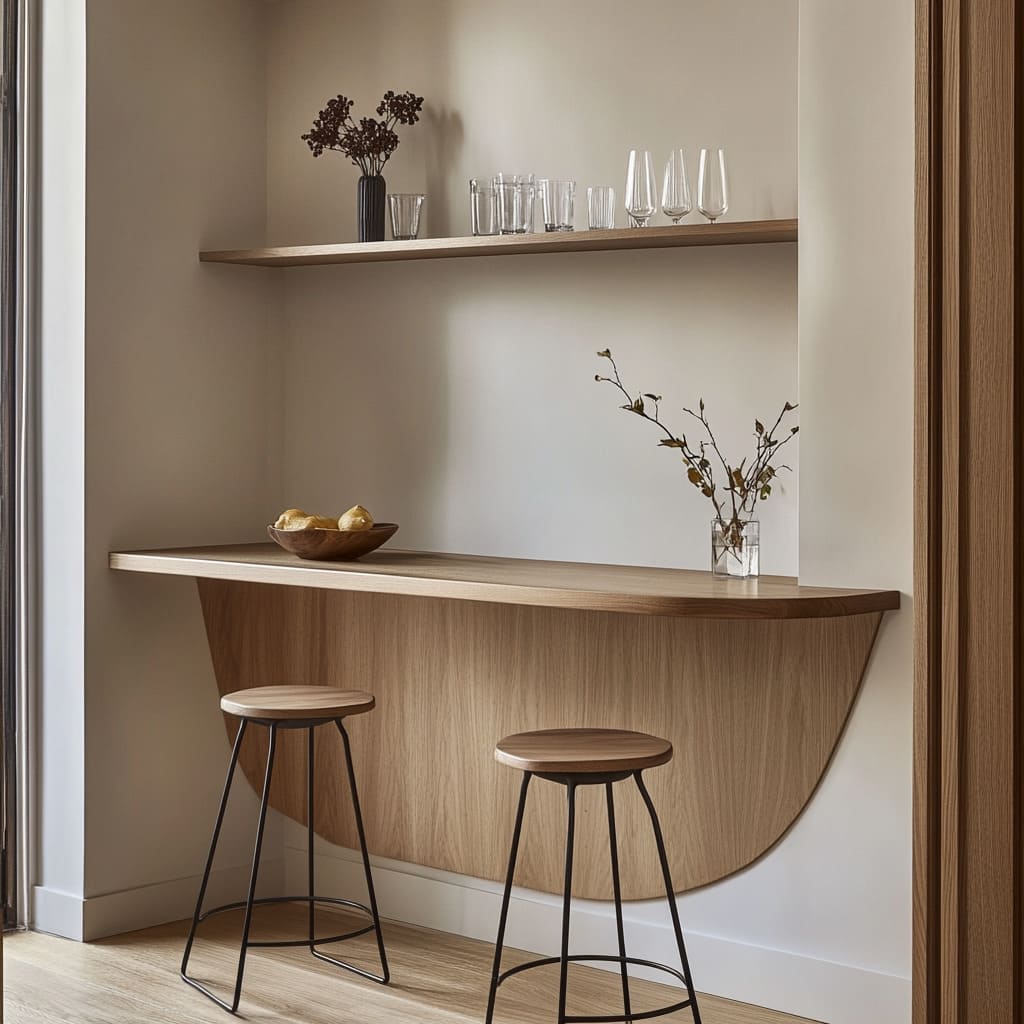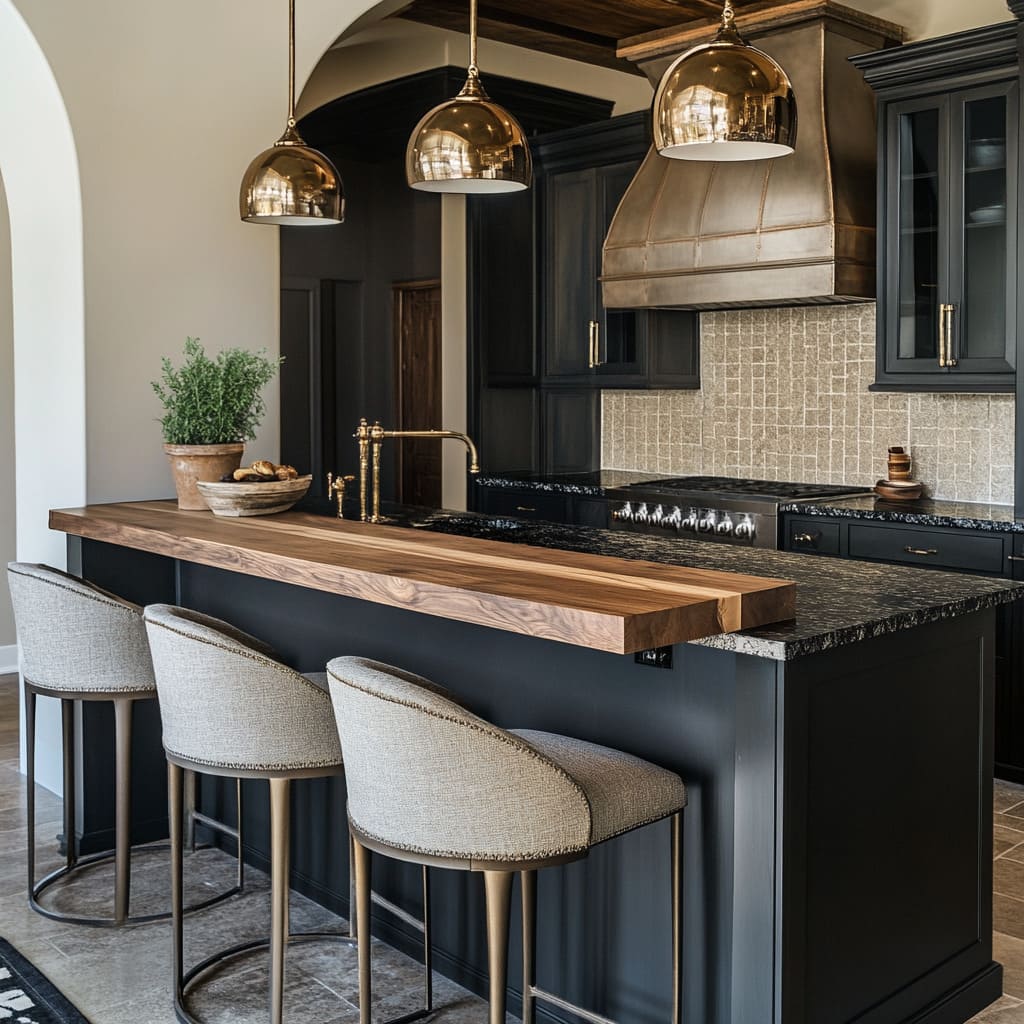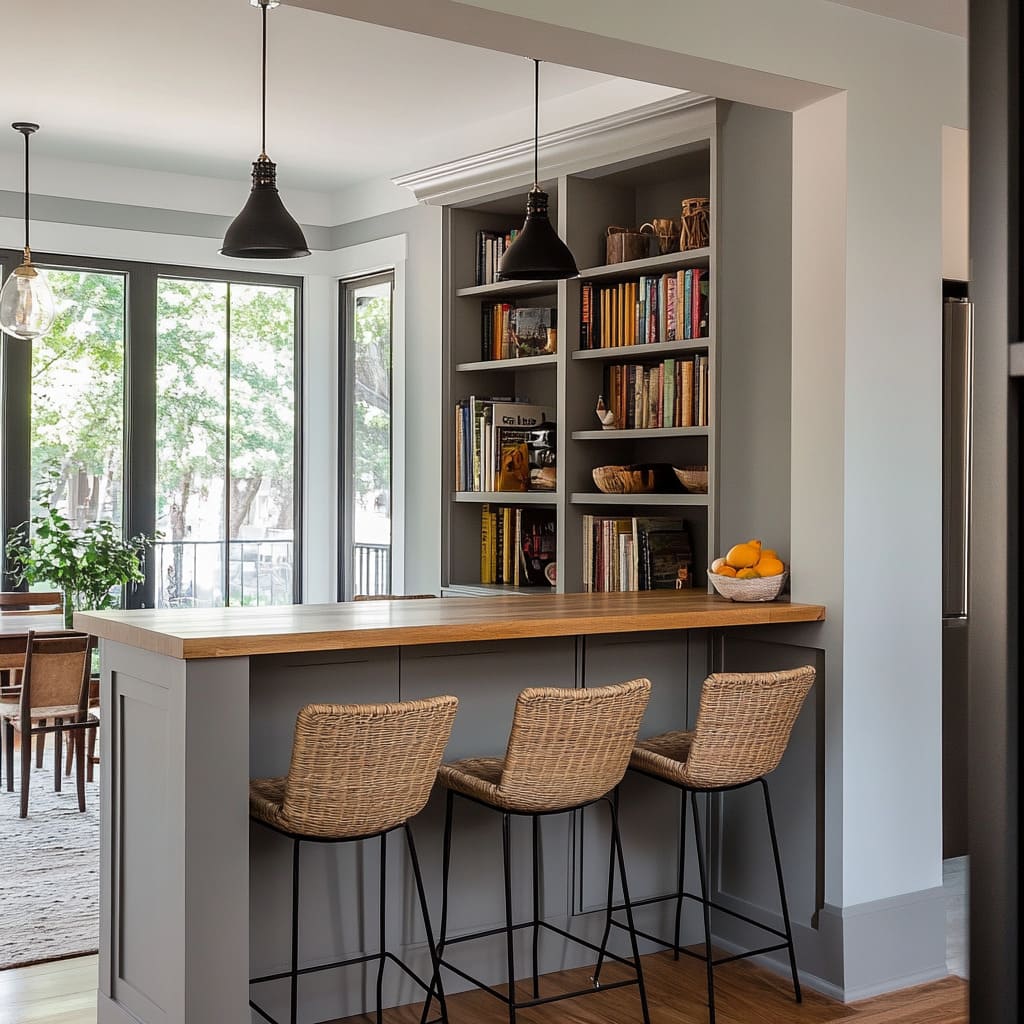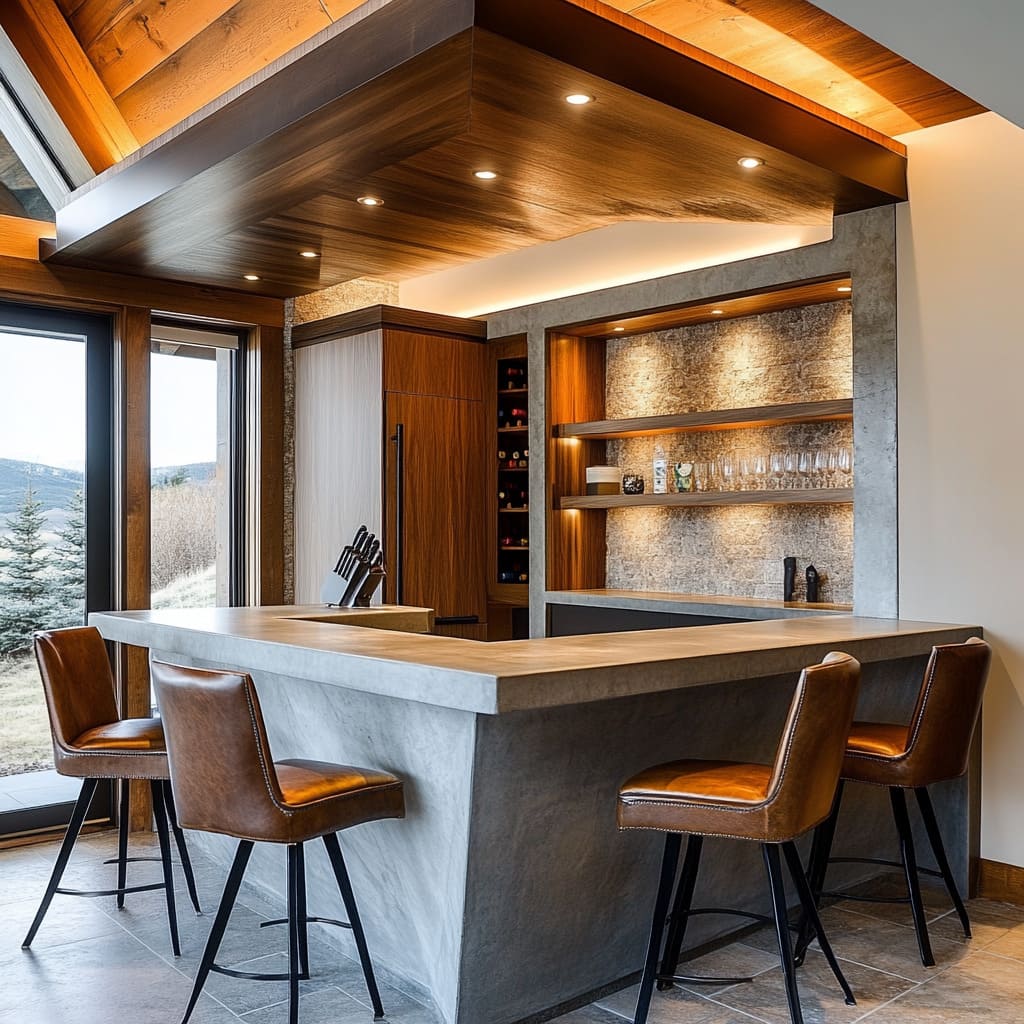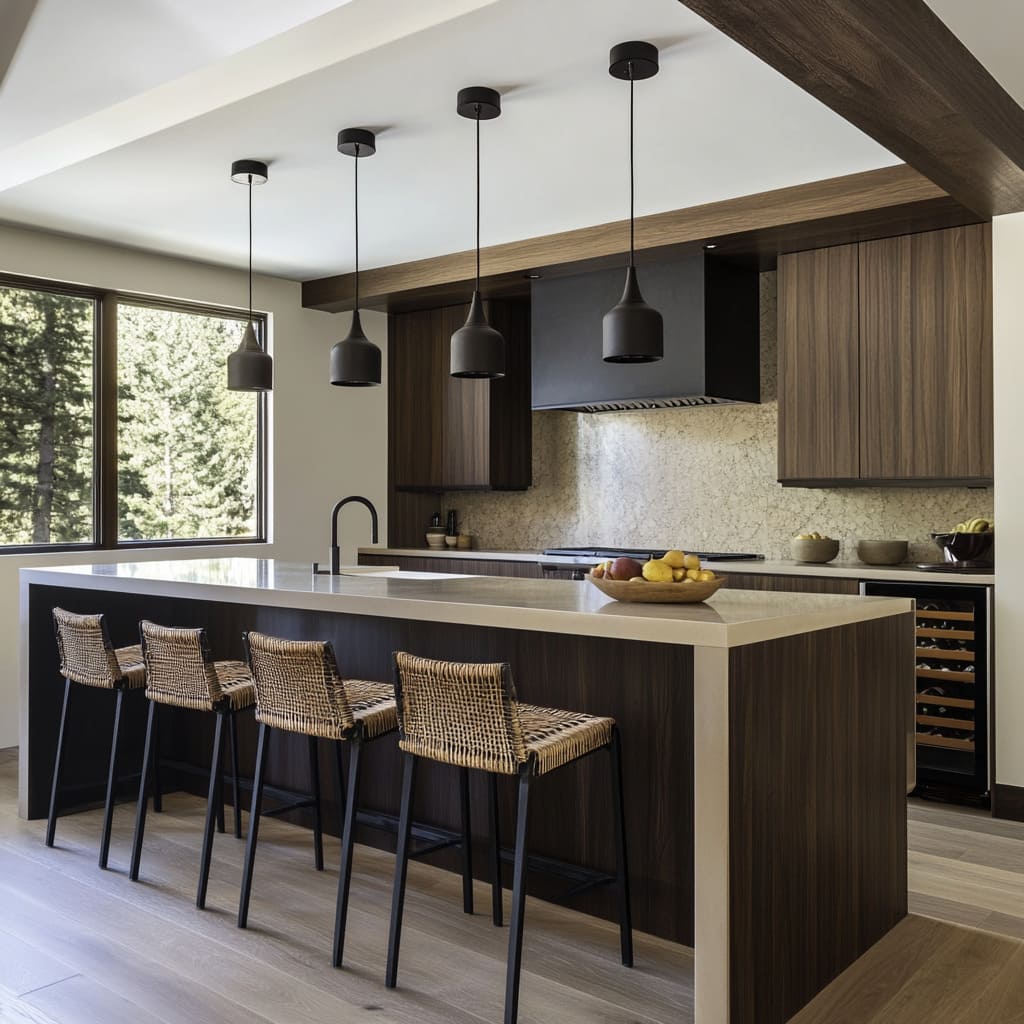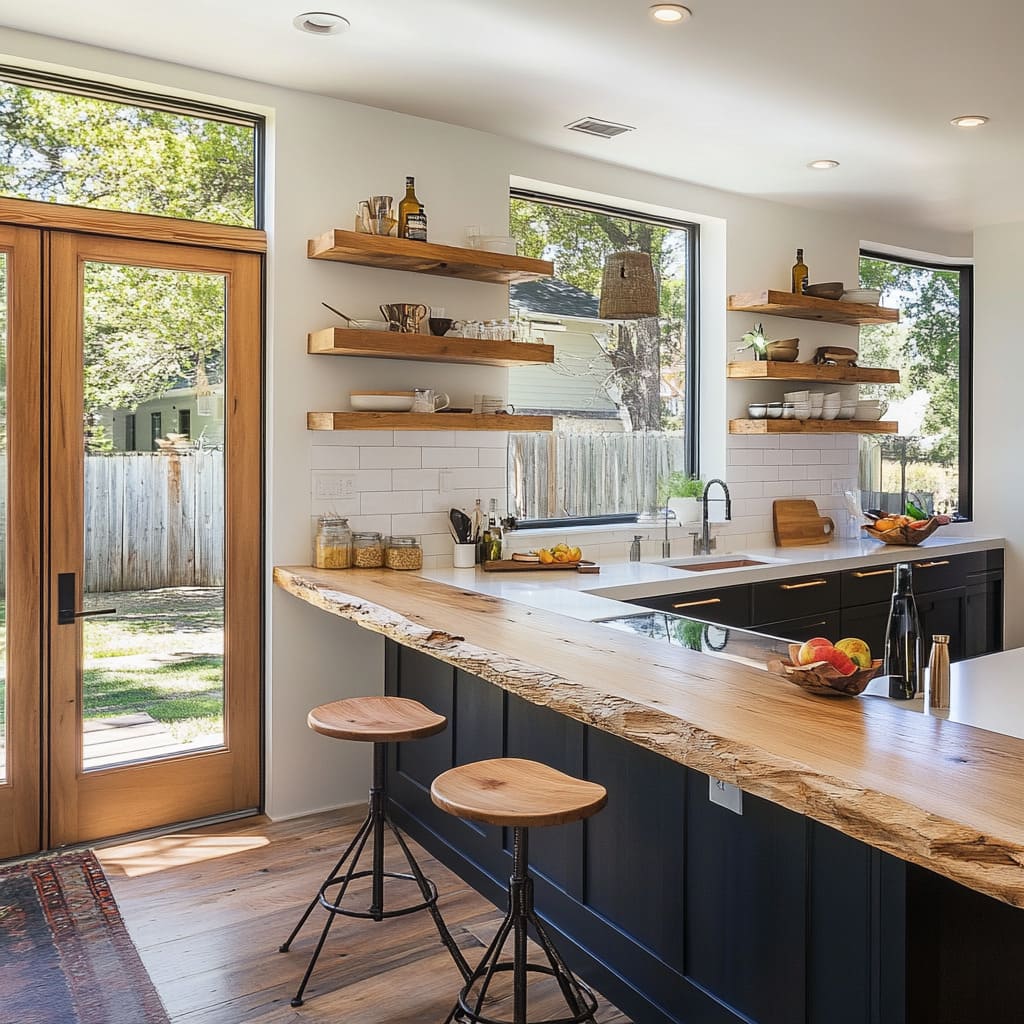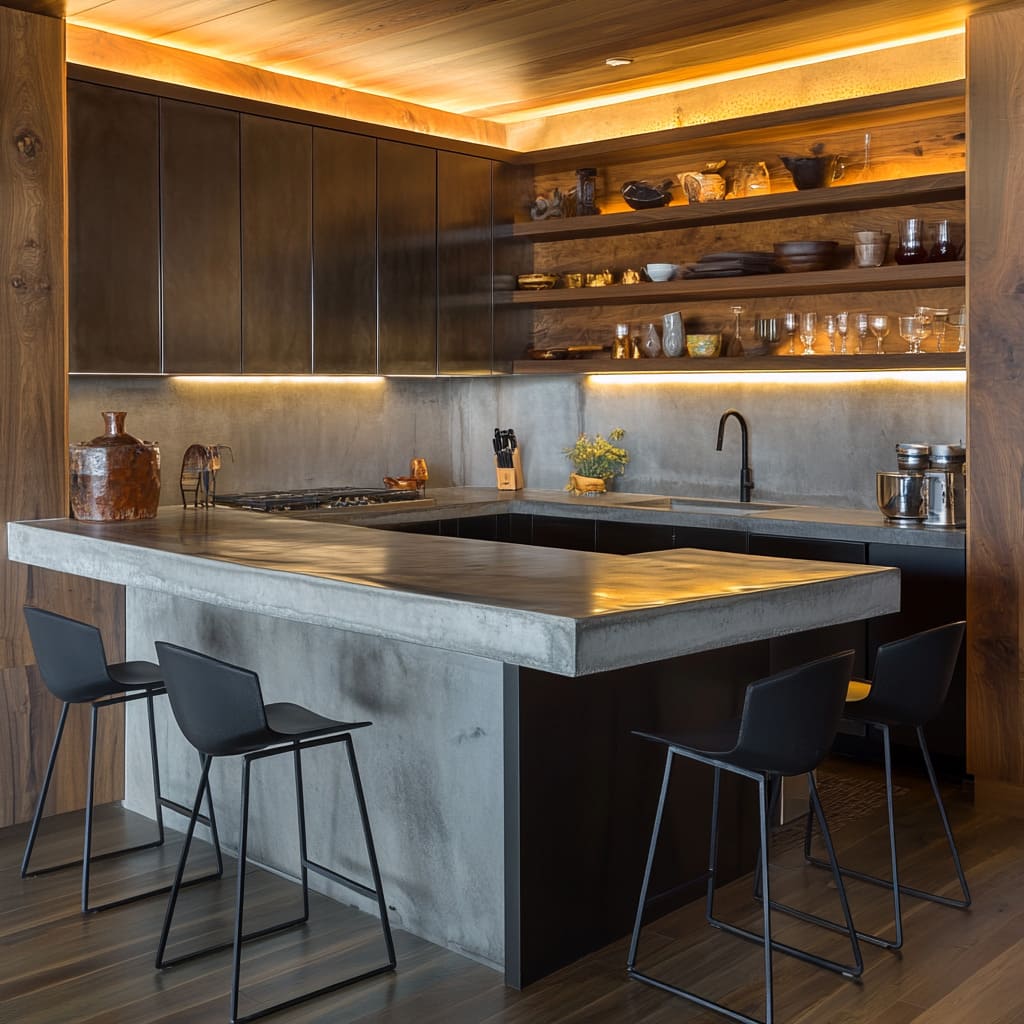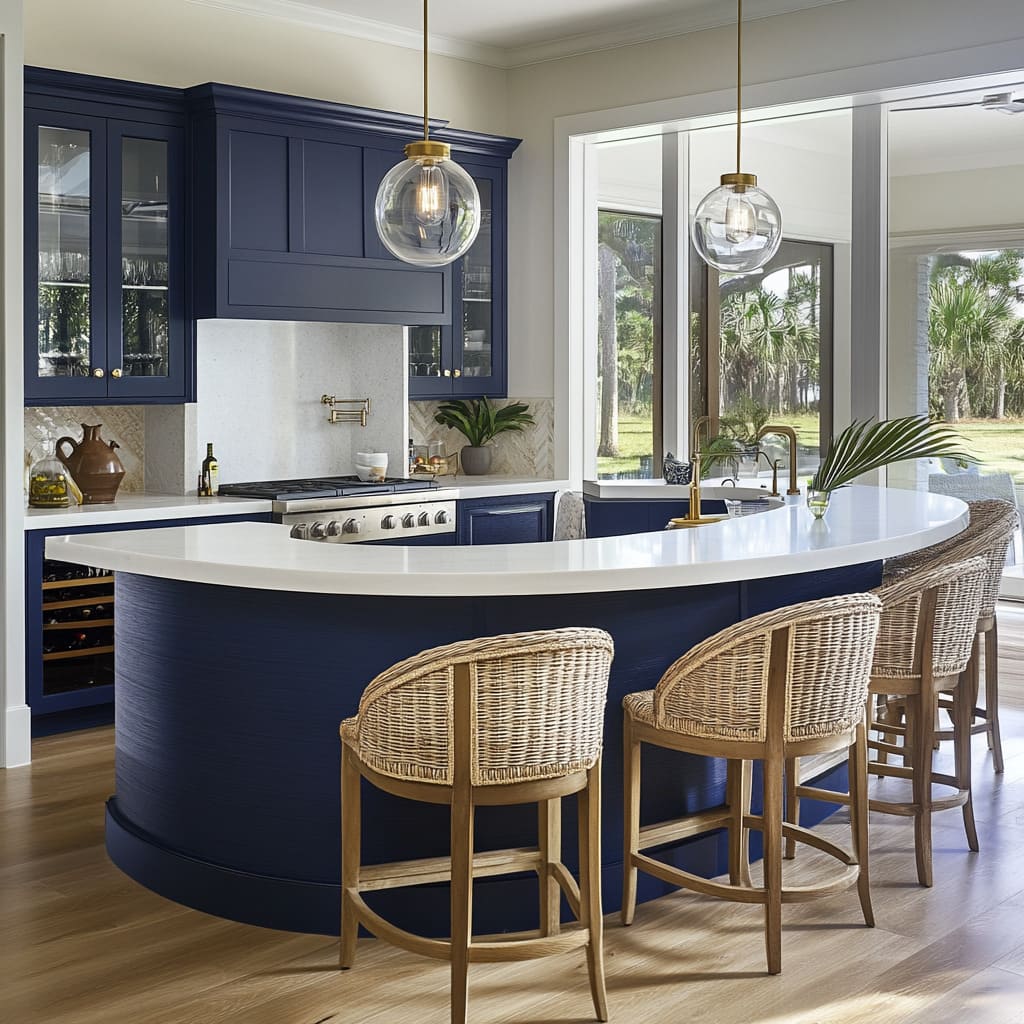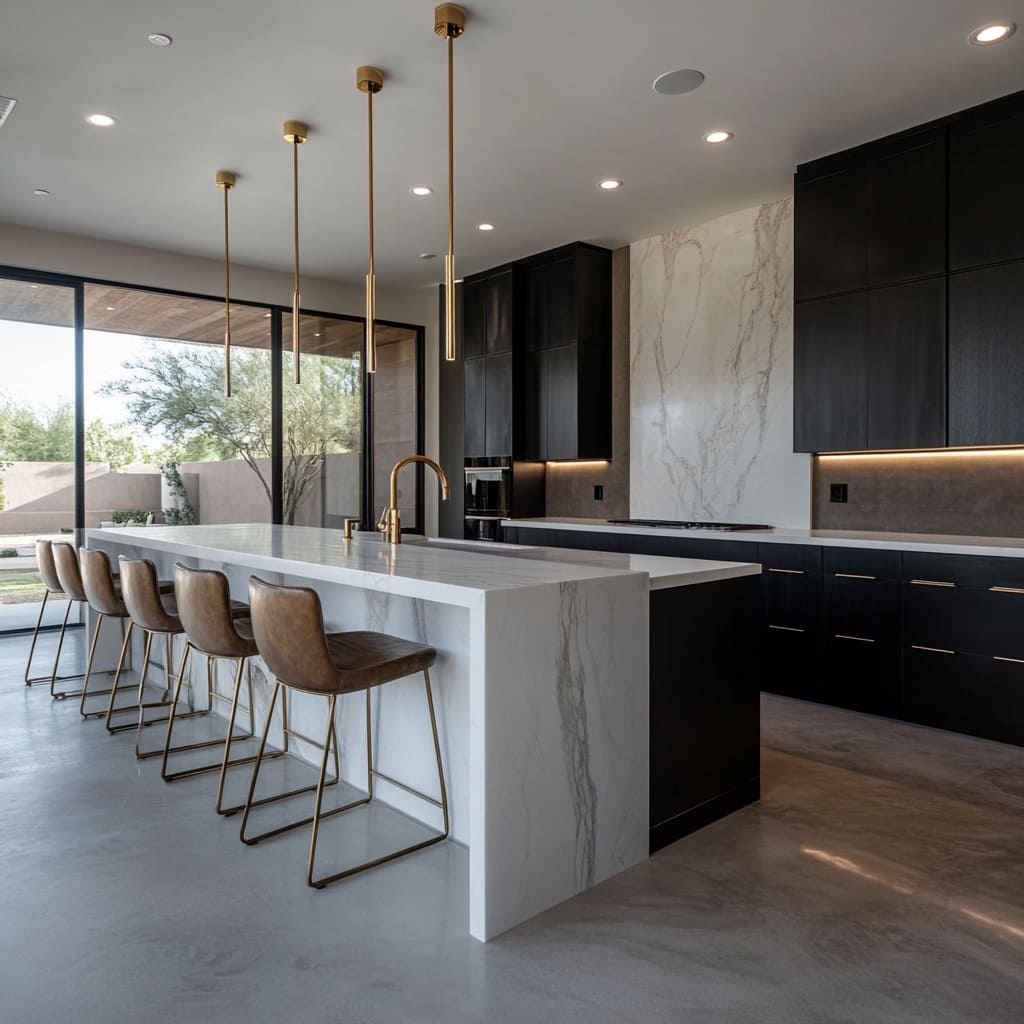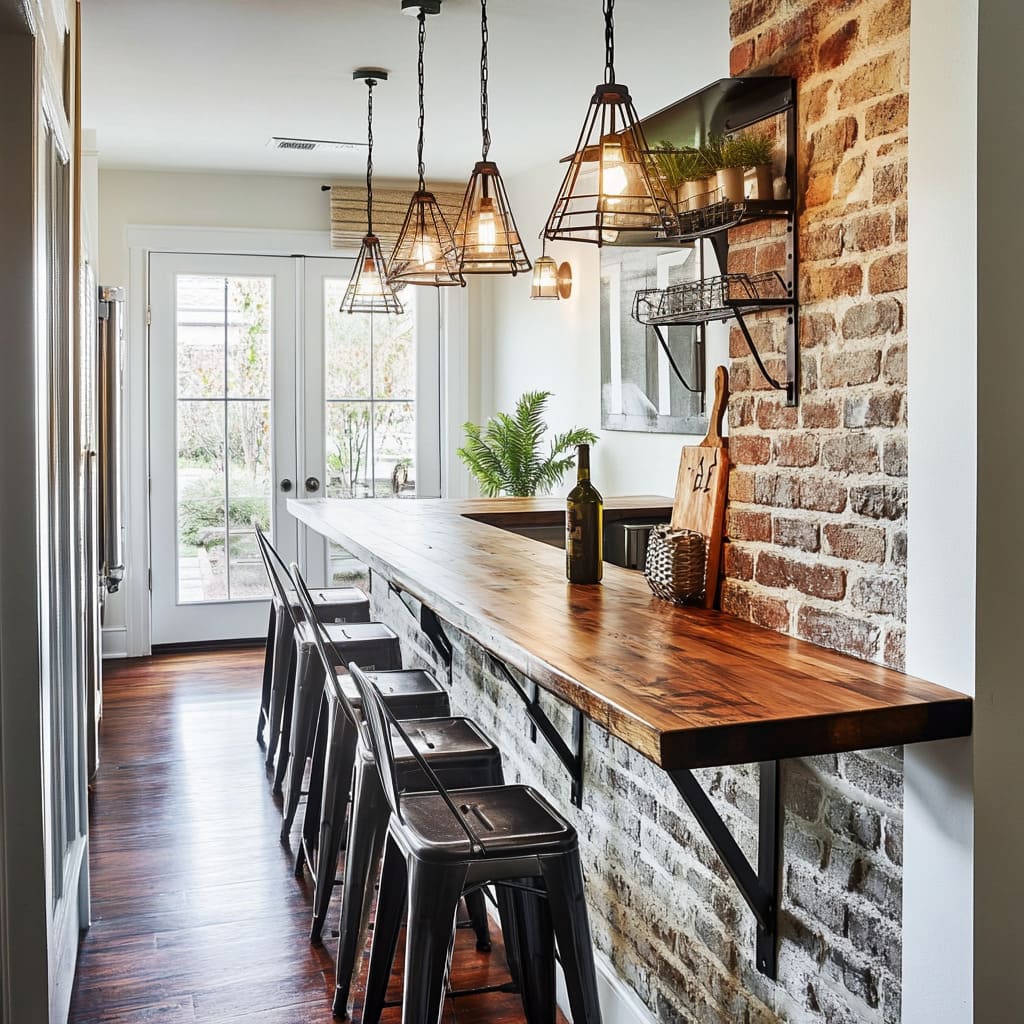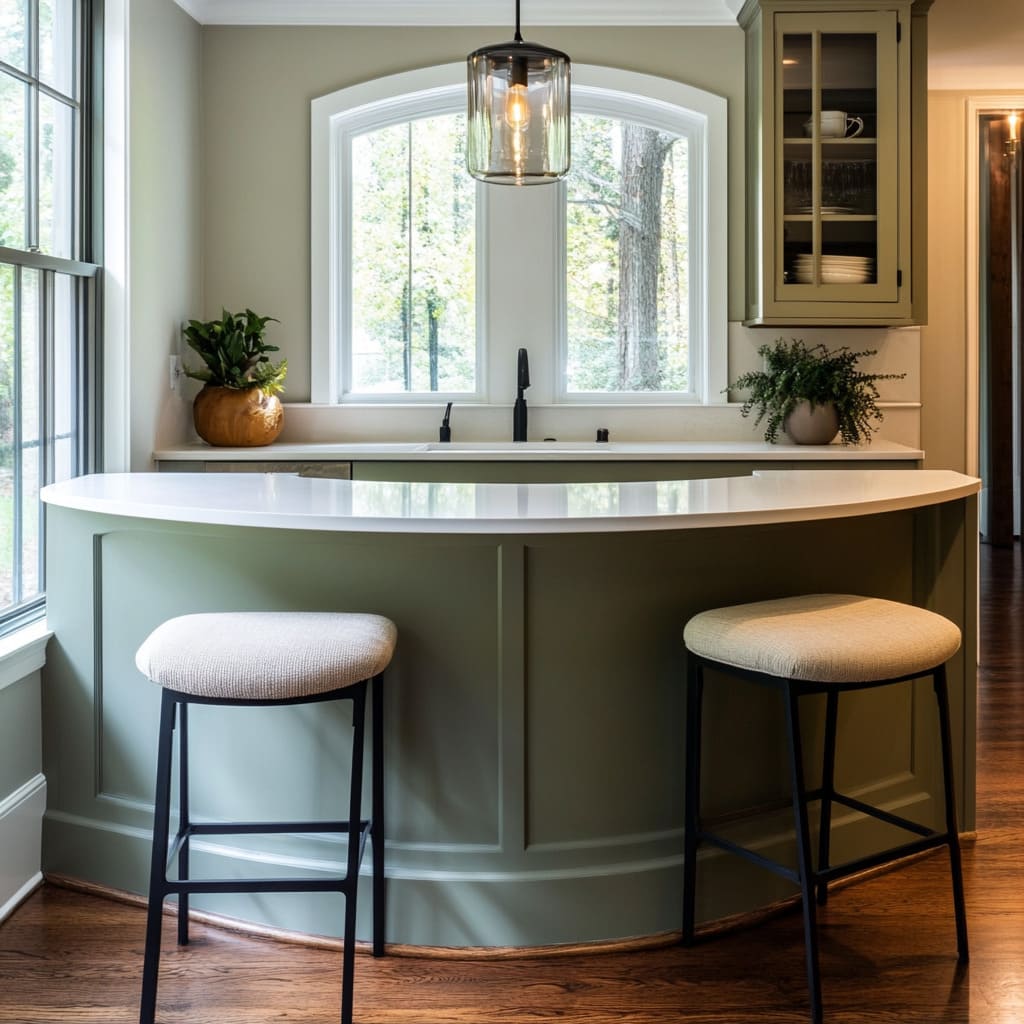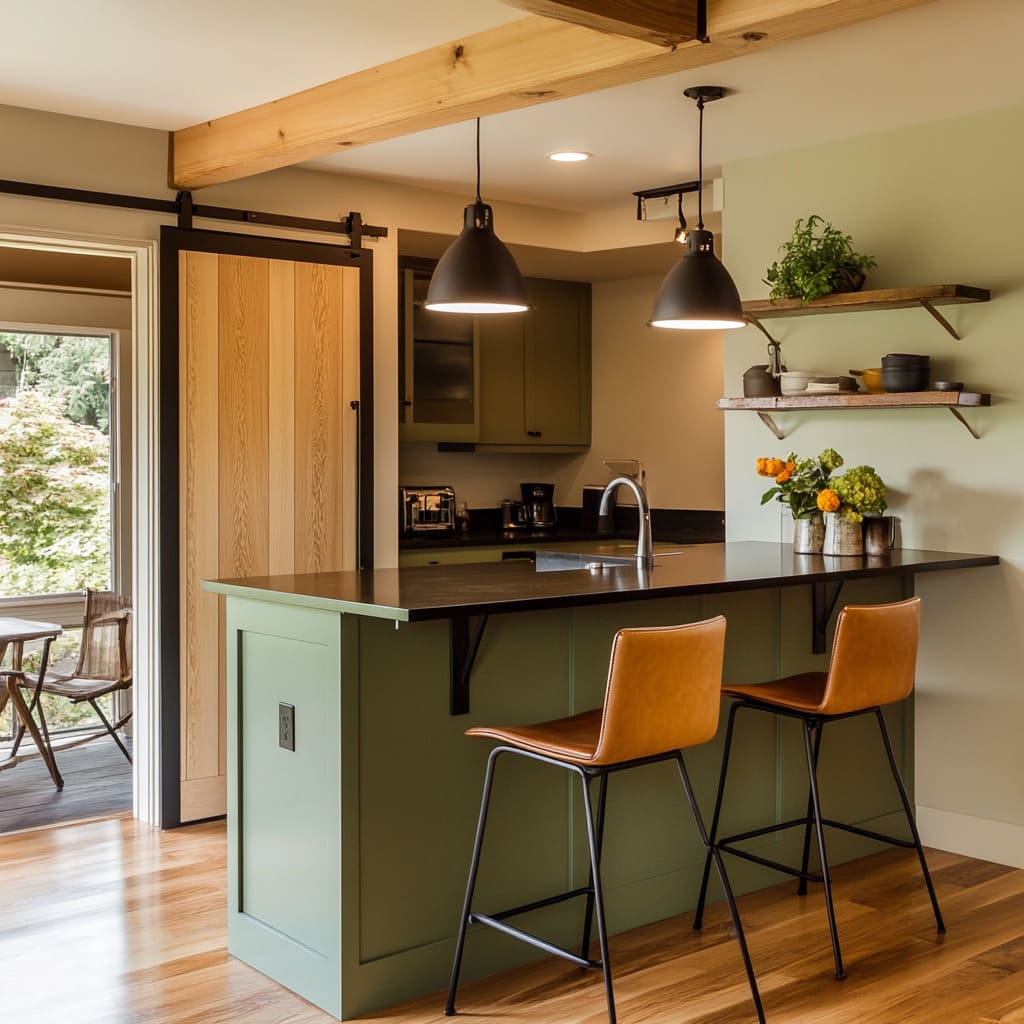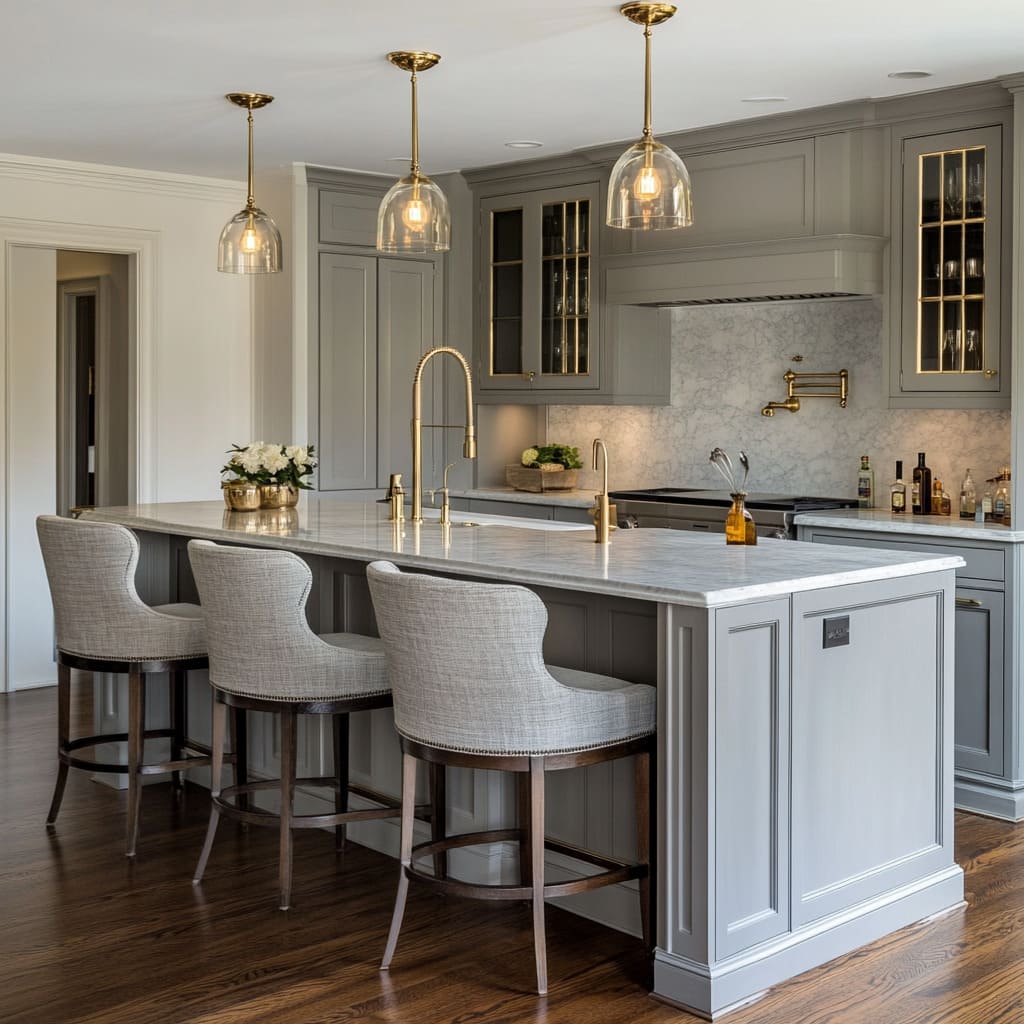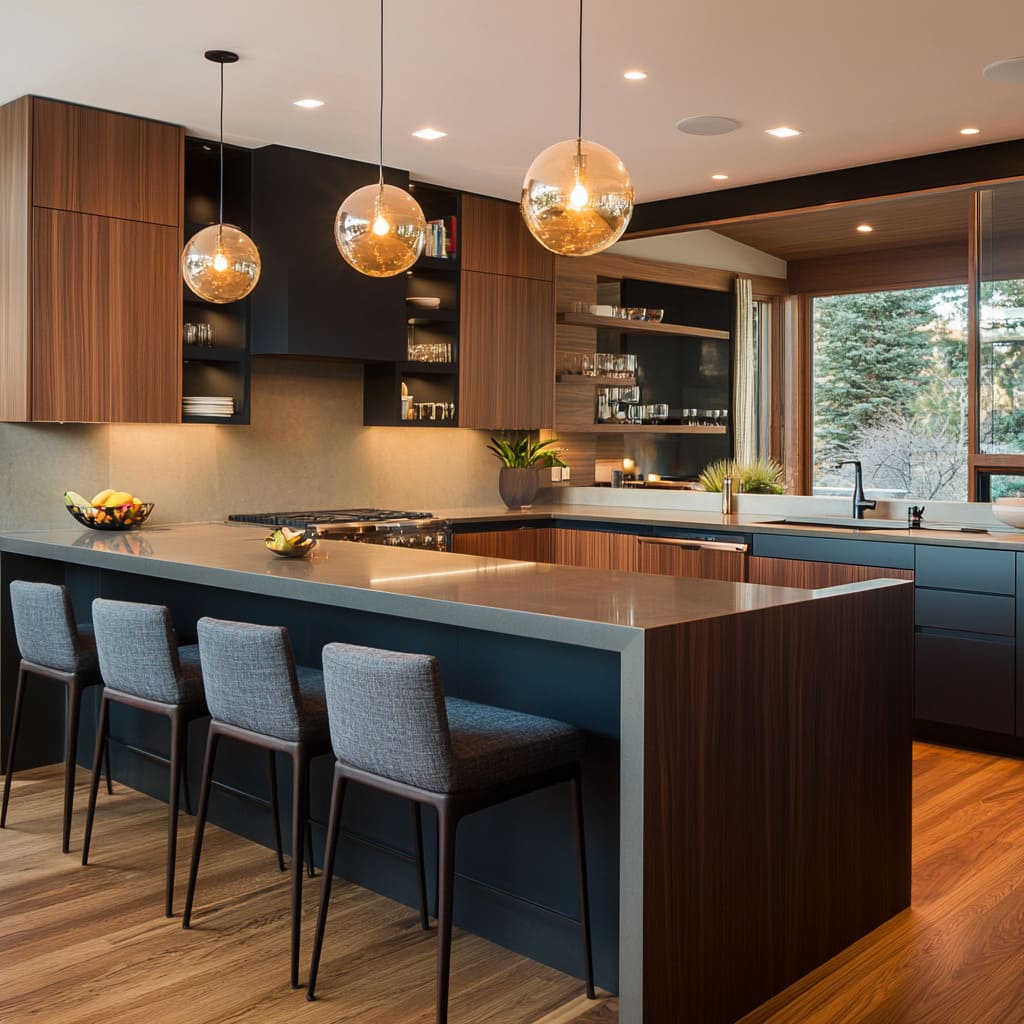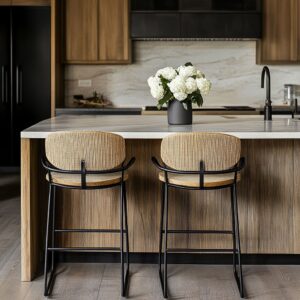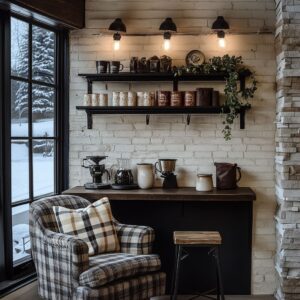A kitchen bar does more than provide a place to pull up a stool—it defines how the space functions and how people interact within it. From bold geometric counters to softly curved islands, these designs show how materials, lighting, and layout choices can shape the entire kitchen experience.
Some spaces lean into strong contrasts, pairing deep wood tones with sleek stone finishes, while others take a more fluid approach with rounded edges and natural textures. Thoughtfully placed lighting highlights textures and adds warmth, making sure dark surfaces don’t feel heavy.
Storage solutions, whether in the form of open shelving or retractable extensions, prove that style and function can go hand in hand.
Whether you’re planning a kitchen refresh or looking for kitchen bar ideas that maximize space, the right balance of design elements makes all the difference. It’s not just about adding a countertop—it’s about choosing the materials, shapes, and finishes that make the space feel complete.
Raw Materials and Soft Accents in Kitchen Bar Design
One of the most intriguing aspects of kitchen bar design is the way materials interact to create contrast, depth, and warmth. A great example of this can be seen in an asymmetrical concrete counter that boldly defines the space with its sculptural presence.
While concrete might seem cold or industrial on its own, pairing it with warm wooden ceiling panels completely changes the dynamic. The wood softens the concrete’s rigid form, creating a space that feels inviting rather than stark.
What makes this design even more interesting is how the angular geometry of the counter is reflected in the ceiling. This repetition isn’t just for aesthetics—it ties the upper and lower halves of the kitchen together, creating a sense of cohesion.
Instead of a counter that simply exists within a room, this approach turns it into an architectural statement, blending function with a striking visual effect.
This layering of textures—hard concrete, rich wood, and even smooth leather barstools—proves that contrast isn’t just about color. It’s about finding the right mix of materials that complement each other, balancing structure with warmth.
Whether in a modern urban loft or a contemporary home with industrial influences, this approach shows how thoughtful material choices can elevate a kitchen bar from a simple seating area to a standout design feature.
Multi-Level Kitchen Bars
Layered kitchen bars do more than break up a flat surface—they introduce a dynamic structure that enhances both function and design. A two-tier counter, for example, isn’t just a stylistic choice; it creates distinct zones for different tasks.
The upper level, slightly elevated, serves as a casual dining area or a convenient spot for guests to sit and chat. Meanwhile, the lower section remains dedicated to meal prep, ensuring that cooking and socializing can happen at the same time without getting in each other’s way.
Beyond practicality, this design approach adds an architectural element that makes the kitchen feel more structured. Instead of a single horizontal plane, the tiered design introduces depth and movement, preventing the space from looking too uniform.
When combined with rich materials—such as concrete, natural wood, or even stone—these multi-level counters create a kitchen that feels thoughtfully designed rather than simply arranged.
Another advantage that often goes unnoticed is how this layout naturally separates activities. The raised tier subtly acts as a barrier between food preparation and the seating area, reducing clutter in high-traffic kitchens.
This makes it a great option for open-concept homes where a seamless balance between functionality and social interaction is key.
The Impact of Curved Bar Counters on Flow and Social Connection
A well-planned bar counter design does more than provide a place to sit—it shapes the way people interact within a kitchen. Curved designs, whether semi-circular or softly rounded, create a seating arrangement that encourages conversation.
Unlike linear setups, where guests sit side by side facing in one direction, a curved counter allows people to engage more naturally, making eye contact and feeling more connected. This small but meaningful shift transforms the space from a simple dining spot into a true social hub.
Beyond functionality, curves introduce a visual softness that can balance out the rigid lines often found in modern kitchens. Straight edges, sharp angles, and uniform cabinetry can sometimes feel too structured, but a gentle curve adds a sense of movement.
This approach works exceptionally well in contemporary interiors, where sleek finishes and minimalist layouts benefit from an organic counterpoint. A rounded shape also improves the natural flow of the space, making movement around the kitchen feel smoother and less restrictive.
Whether in a coastal-inspired home where a curved island mimics the shape of ocean waves or in a high-end space where a sweeping marble counter takes center stage, this design approach enhances both practicality and aesthetics. It’s a subtle yet effective way to make a kitchen feel more inviting without sacrificing modern sophistication.
Striking the Right Balance: Dark Tones and Natural Wood in Kitchen Bars
A kitchen with a deep, moody color scheme can feel bold and sophisticated, but without the right elements to soften it, the space might appear too severe. This is where bar area ideas that incorporate warm wood textures become essential.
When dark cabinetry, black quartz, or concrete backsplashes take center stage, the introduction of live-edge countertops, natural grain shelving, or walnut paneling keeps the design from feeling flat. The contrast between matte black finishes and organic wood surfaces creates a layered look that feels rich and intentional rather than overwhelming.
Lighting plays a major role in making these darker elements work. Without proper illumination, the intricate details in the wood grain or the polished finish of a black countertop can get lost in the shadows.
Strategically placed pendant lights, under-cabinet lighting, or recessed LEDs ensure that these features remain visible, enhancing the depth and texture of the materials. Large windows can also help by allowing daylight to highlight the contrast between deep tones and natural wood.
This mix of dark and organic elements works well in both industrial and modern farmhouse designs, where metal accents and raw materials coexist seamlessly. Whether in a city loft with exposed brick and steel or a cozy home with rustic oak flooring, this balance of bold and warm tones gives the bar area a refined yet welcoming feel.
The Power of Lighting: Setting the Mood for a Kitchen Bar
Lighting does far more than brighten a space—it directs attention, enhances textures, and defines the overall feel of a kitchen bar. Whether through subtle under-shelf illumination or dramatic pendant lights, the right choices can transform an ordinary setup into a striking design feature.
In many kitchen ideas with bar, recessed LED strips are used to create a soft, indirect glow, ensuring that shelves and countertops remain well-lit without overpowering the surrounding materials. This technique works especially well in modern or minimalist spaces, where clean lines and subtle contrasts take priority.
For those looking to make a stronger statement, oversized glass pendants or dome fixtures suspended above the bar introduce a sense of height and dimension. These hanging lights do more than provide brightness—they anchor the design by drawing the eye upward, creating a layered effect that balances the lower cabinetry and countertops.
The choice of fixture style also makes a difference; matte black metal frames lend an industrial feel, while brass or aged gold elements add a refined touch.
Beyond aesthetics, proper lighting ensures that materials like polished marble, natural wood, or textured concrete are fully appreciated. Without it, dark countertops may lose their depth, and intricate grain patterns in wood may go unnoticed.
Strategic placement of warm lighting can bring out the richness in these materials, making the space feel more inviting while maintaining a well-defined visual hierarchy.
Smart Storage Solutions: Making the Most of a Kitchen Bar
A well-designed kitchen bar is more than just a seating area—it can also function as a practical storage solution without compromising style. Thoughtfully integrated shelving, hidden compartments, and innovative pull-out features ensure that everything has its place while maintaining a clean, uncluttered look.
Open shelving behind or above the counter is a simple yet effective way to keep essential items within reach, while also allowing for curated displays of dishware, cookbooks, or decorative accents. The right balance of exposed and concealed storage prevents the space from feeling either too busy or too sparse.
One of the most creative kitchen bar cabinet ideas involves a retractable extension built into the counter, which slides out when additional space is needed. This type of design is particularly useful in kitchens with limited square footage, as it allows for extra seating or prep space only when necessary.
When not in use, the extension seamlessly tucks away, maintaining the bar’s sleek profile.
Beyond traditional cabinetry, designers are finding new ways to blend storage with aesthetics. Built-in wine racks, recessed shelving, or even under-counter drawers can make a kitchen bar more functional while keeping frequently used items close at hand.
The key is to incorporate these features naturally into the design, ensuring that they feel like an intentional part of the space rather than an afterthought.
Blending Classic and Modern: A Fresh Take on Kitchen Bar Design
Traditional design elements like curved corbels, paneled cabinetry, and tufted seating have long been associated with warm, inviting interiors. But today’s kitchens often mix these timeless features with sleek, modern materials to create a look that feels both established and up to date.
A bar island with detailed woodwork, for example, gains a more contemporary edge when paired with a smooth marble or concrete countertop. Similarly, tufted barstools in soft fabric upholstery can introduce a sense of classic comfort in a space otherwise defined by sharp, minimalist lines.
The key to this balanced approach is contrast—layering old-world charm with modern simplicity. Many bar island ideas incorporate vintage-style lighting fixtures alongside clean, handle-free cabinetry, or use rich, natural wood tones against a backdrop of polished stone.
These combinations prevent the space from feeling too locked into one particular style. Instead of being entirely farmhouse, industrial, or contemporary, the result is a bar that feels adaptable and personal.
This mix of eras also allows for flexibility in décor. A kitchen that embraces both traditional and modern influences can easily be refreshed with small updates, like changing the barstools, hardware, or lighting.
By carefully selecting elements that bridge different styles, the space remains timeless rather than following a passing trend.
How Color Blocking Defines a Kitchen Bar
A simple yet highly effective way to make a kitchen bar stand out is through color blocking. This technique uses bold, contrasting shades to emphasize different elements of the design, making the entire structure feel more intentional.
Many kitchen bars incorporate deep navy or matte black cabinetry beneath a crisp white countertop, instantly drawing attention to the form of the island. Others use dark wood bases against polished marble, creating a layered effect that enhances the overall depth of the space.
The advantage of this approach is that it naturally directs the eye, making the countertop appear more substantial and giving the kitchen a structured, well-balanced feel. In spaces with generous natural light, these contrasts become even more striking.
Sunlight bouncing off a white quartz top set against dark cabinetry makes the surfaces feel even more dimensional, highlighting subtle textures like veining in the stone or the grain of the wood.
Beyond aesthetics, color blocking can also influence the perception of space. A lighter countertop on a darker base helps define the working zone, creating a visual separation between the prep area and seating.
This method works particularly well in open-concept kitchens, where defining different sections without physical dividers is key. By using strong color pairings, a kitchen bar becomes more than just a functional element—it turns into a design statement that shapes the entire feel of the room.
How Windows Transform a Kitchen Bar
The placement of a kitchen bar in relation to windows or glass doors is far more intentional than it might seem at first glance. When positioned near a large window or an open patio entry, the bar becomes an extension of both the kitchen and the outdoor environment, creating a seamless flow between spaces.
This design strategy brings in natural light, making the entire kitchen feel more open while enhancing the textures of materials like wood, marble, or metal finishes.
In kitchens with darker tones, daylight plays an essential role in preventing the space from feeling enclosed. Black cabinetry or deep wood accents absorb light, so having a window nearby ensures that the richness of these materials remains visible instead of fading into the background.
The effect is even more striking when natural materials—such as rattan barstools, reclaimed wood counters, or stone backsplashes—echo the tones of the landscape outside, subtly reinforcing a connection to nature.
Beyond aesthetics, well-placed windows also shape the mood of the space. A kitchen bar bathed in daylight feels casual and inviting, making it a natural spot for morning coffee or afternoon conversation.
At night, when artificial lighting takes over, the bar transforms into a warm, intimate setting, shifting its role from a daytime gathering point to an atmospheric focal feature.
By integrating kitchen bars with surrounding views, designers ensure that they don’t feel like isolated installations but instead serve as functional, visually connected elements within the larger flow of the home. Whether framing a scenic backyard or simply allowing more daylight to brighten a compact space, the strategic use of windows enhances not just the look but also the experience of the kitchen.
Bringing It All Together: A Kitchen Bar That Works for You
A well-designed kitchen bar isn’t just about extra seating or an extra surface—it’s about making the most of your space in a way that suits your home’s style and daily life. Whether it’s the contrast of dark cabinetry against warm wood, the sleek edge of a marble counter, or the way natural light enhances every detail, each design choice shapes both function and atmosphere.
From bold, angular layouts to soft, curved islands, these designs show that a kitchen bar can be as sculptural as it is practical. Thoughtful lighting, strategic storage, and the right balance of materials all play a role in making the space feel cohesive.
Even smaller details, like the shape of barstools or the placement of shelving, help define how the bar interacts with the rest of the kitchen.
At its best, a kitchen bar isn’t just a standalone feature—it’s a natural extension of how you cook, gather, and move through the space. Whether you’re working with a compact layout or a spacious open-plan design, the key is choosing elements that complement both the architecture and your lifestyle.
With the right mix of structure and flexibility, your kitchen bar can become more than just a stylish addition—it can be the spot where the best moments happen.
